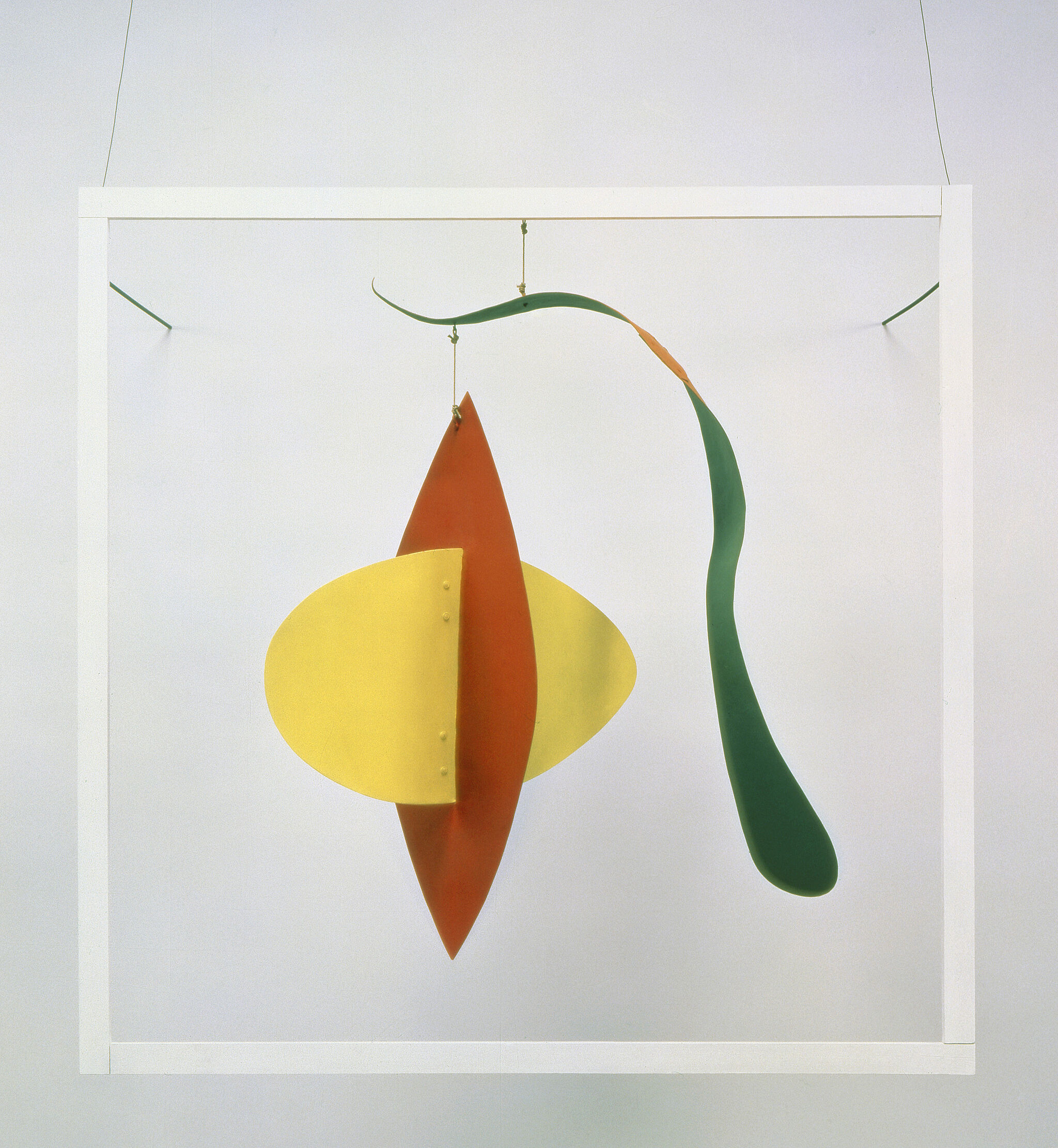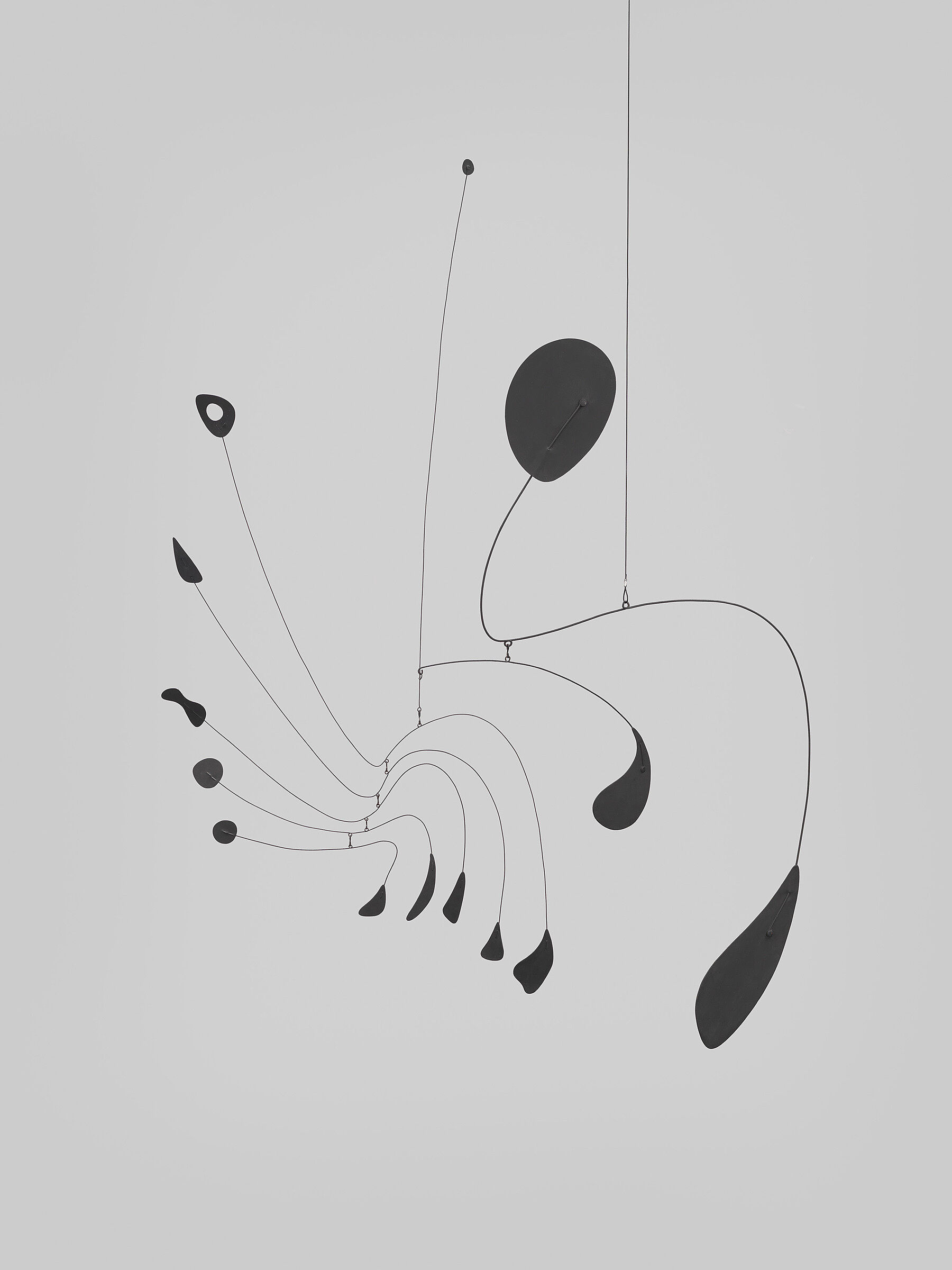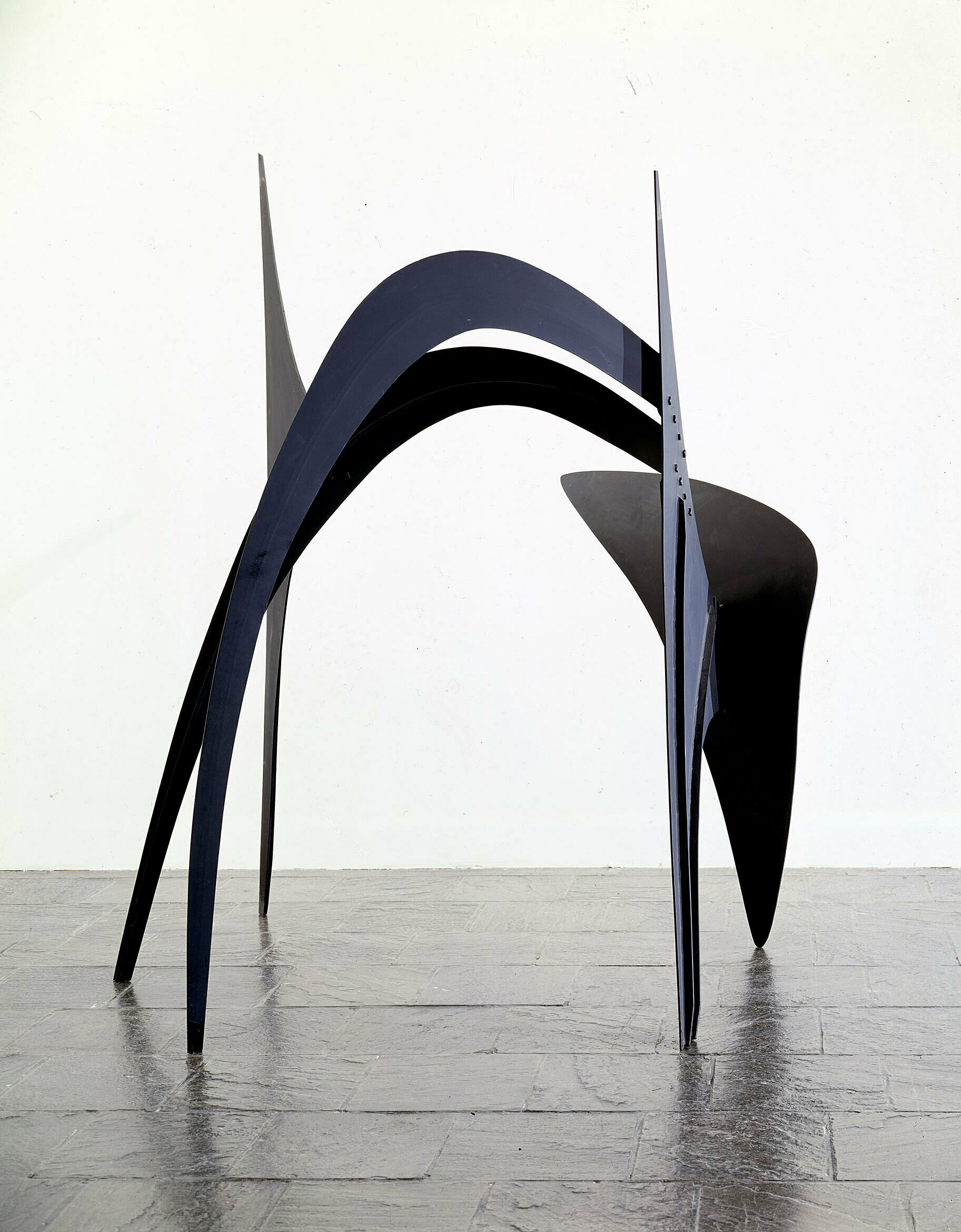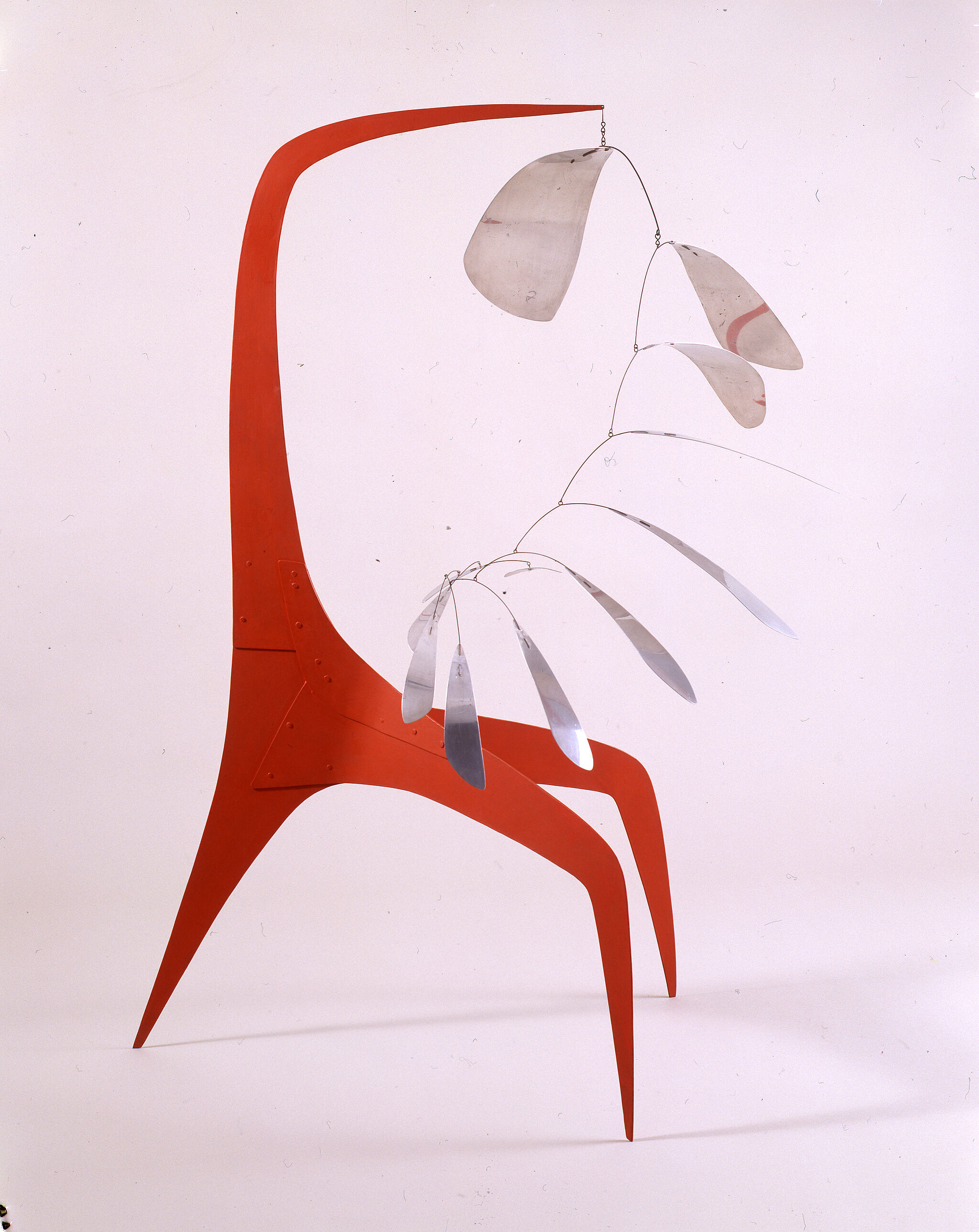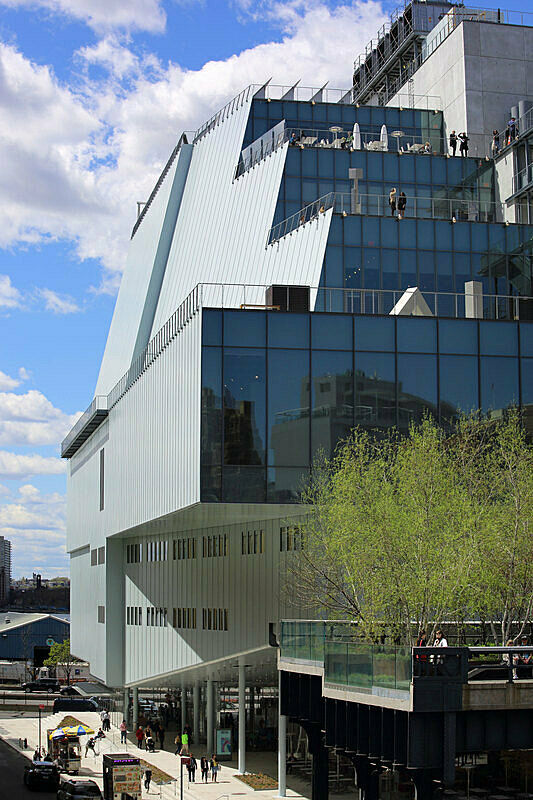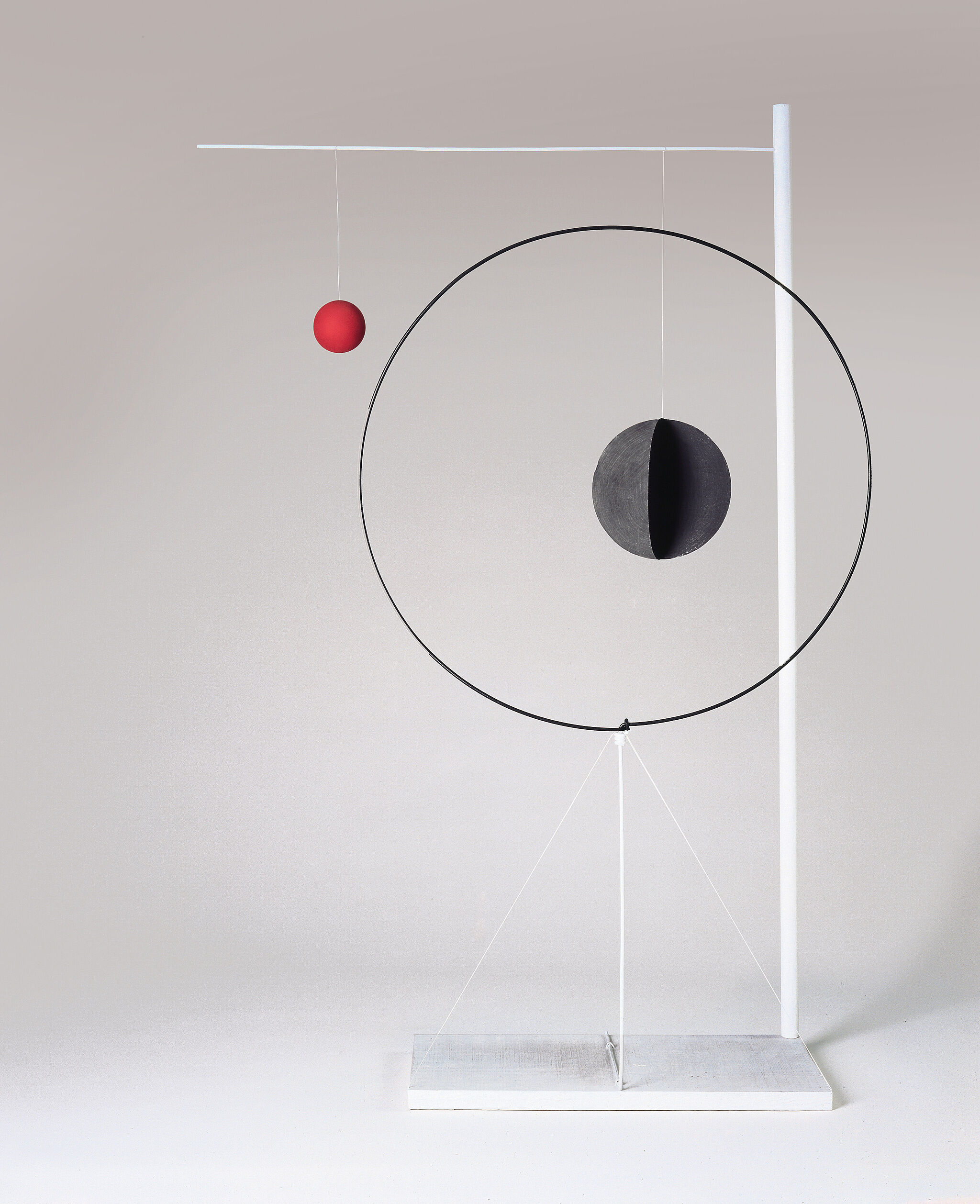Calder: Hypermobility
June 9–Oct 23, 2017
Daily gallery activations of Calder exhibition works will occur at the following times:
Monday–Thursday: 12 pm, 2 pm, 4 pm
Friday: 11 am, 12 pm, 2 pm, 4 pm, 7:30 pm, 8 pm, 9 pm
Saturday and Sunday: 11 am, 12 pm, 1 pm, 2 pm, 3 pm, 4 pm
Calder: Hypermobility focuses on the extraordinary breadth of movement and sound in the work of Alexander Calder. This exhibition brings together a rich constellation of key sculptures and provides a rare opportunity to experience the works as the artist intended—in motion. Regular activations will occur in the galleries, revealing the inherent kinetic nature of Calder’s work, as well as its relationship to performance. Influenced in part by the artist’s fascination and engagement with choreography, Calder’s sculptures contain an embedded performativity that is reflected in their idiosyncratic motions and the perceptual responses they provoke.
In the early 1930s, Calder invented an entirely new mode of art, the mobile—a kinetic form of sculpture in which carefully balanced components manifest their own unique systems of movement. These works operate in highly sophisticated ways, ranging from gentle rotations to uncanny gestures, and at times, trigger unpredictable percussive sounds. Calder: Hypermobility encompasses major examples of Calder’s work including early motor-driven abstractions, sound-generating Gongs, and standing and hanging mobiles.
In collaboration with the Calder Foundation, the exhibition will feature an expansive series of performances and events, including a number of episodic, one-time demonstrations of rarely seen works, as well as new commissions, which will bring contemporary artists into dialogue with Calder’s innovations and illuminate the many ways in which his art continues to challenge and inform new generations. Participating artists include Christian Marclay with cellist Okkyung Lee, Abigail DeVille with director Charlotte Brathwaite, Jack Quartet, Jill Magid, C. Spencer Yeh, Nora Schultz, Math Bass and Lauren Davis Fisher, Arto Lindsay, and more.
Musician Jim O’Rourke has created an original composition to accompany the exhibition designed to be experienced as a sound walk for the show. Elements of jazz, modern composition, and field recordings interact as gradually reappearing musical components, forming a complex internal structure through their own motions.
Listen to music inspired by the exhibition as selected by Jim O'Rourke, on Spotify.
The exhibition is organized by Jay Sanders, Engell Speyer Family Curator and Curator of Performance, with Greta Hartenstein, senior curatorial assistant, and Melinda Lang, curatorial assistant.
View activations and performances.
Major support for Calder: Hypermobility is provided by the Dalio Foundation, the Jerome L. Greene Foundation, the Philip and Janice Levin Foundation, and the Whitney’s National Committee.
Significant support is provided by The Horace W. Goldsmith Foundation.
Generous support is provided by Irma and Norman Braman, Fairfax Dorn and Marc Glimcher, the Fisher Family, Further Forward Foundation in honor of Susan R. Malloy, Norman and Melissa Selby, and Michelle Smith.
Additional support is provided by the Mitzi and Warren Eisenberg Family Foundation.
Artworks
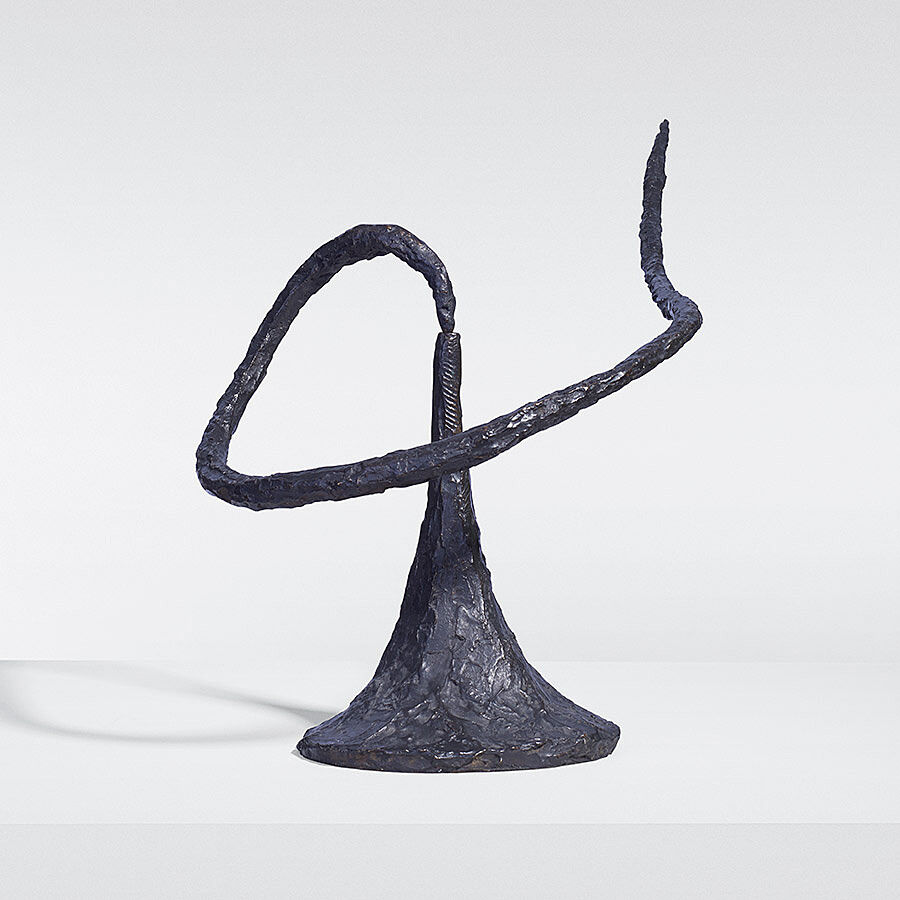

Alexander Calder (1898–1976), Whip Snake (Snake on the Post), 1944. Bronze, 24 1/4 × 24 1/2 × 24 7/8 in. (61.6 × 62.2 × 63.2 cm). Whitney Museum of American Art, New York; purchase with funds from the Howard and Jean Lipman Foundation, Inc. 70.3a-b. © 2017 Calder Foundation, New York / Artists Rights Society (ARS), New York
Videos
Audio
Jim O’Rourke - pedal steel, guitar, double bass
Eiko Ishibashi - piano
Eivind Lonning - trumpet
Joe Talia - drums
-
0:00
Jim O'Rourke, Calder Walk
0:00
Installation Photography
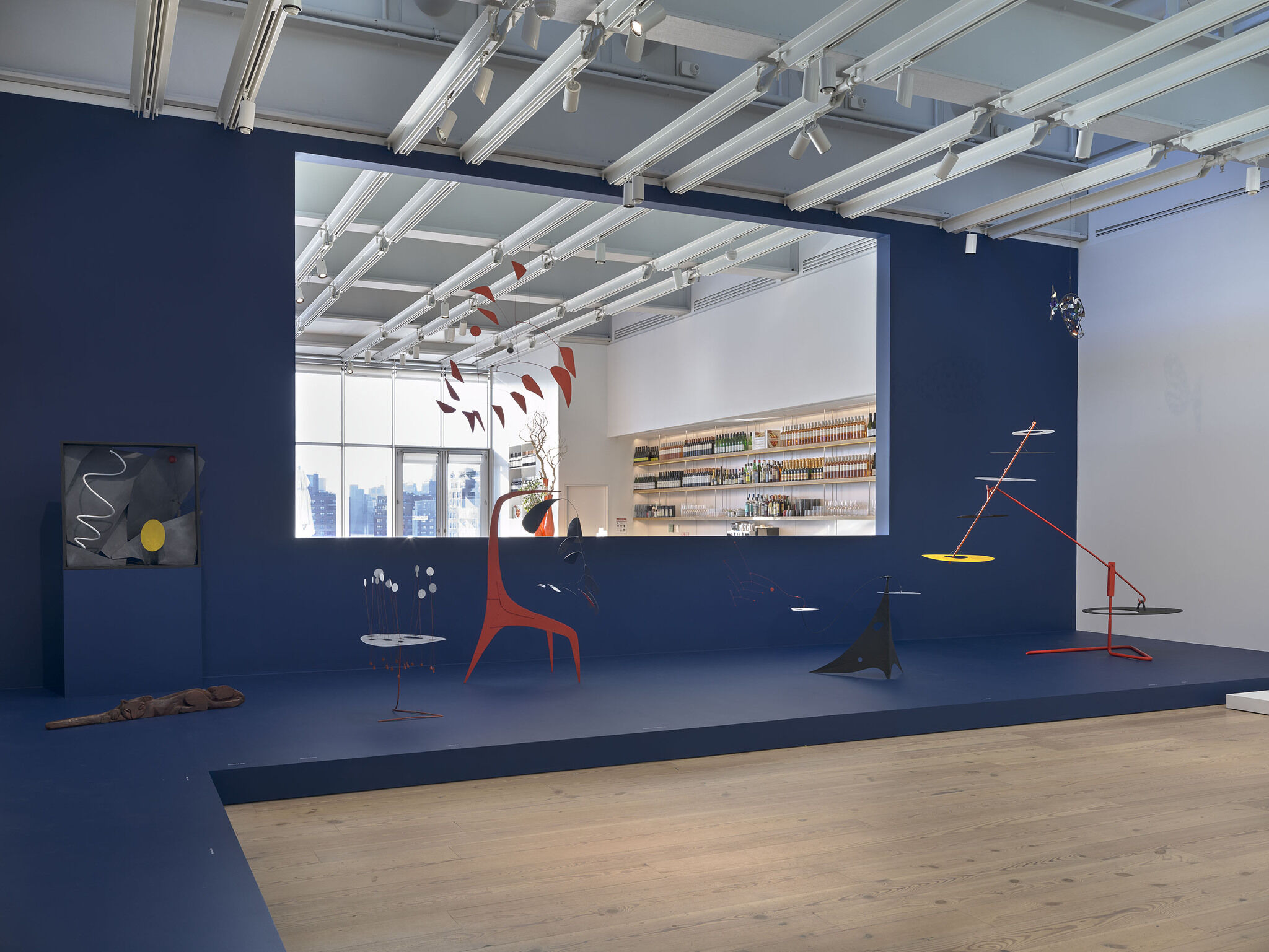

Installation view of Calder: Hypermobility (Whitney Museum of American Art, New York, June 9-October 23, 2017). From left to right (standing): Alexander Calder, Black Frame, 1934, Calder Foundation, New York; Alexander Calder, Double Cat, 1930, Whitney Museum of American Art, New York, purchase with funds from the Howard and Jean Lipman Foundation, Inc. 69.256; Alexander Calder, Aspen, 1948, Calder Foundation, New York; Alexander Calder, Aluminum Leaves, Red Post, 1941, The Lipman Family Foundation, long term loan to the Whitney Museum of American Art, T.1996.7; Alexander Calder, Parasite, 1947, Calder Foundation, New York, promised gift of Holton Rower; Alexander Calder, Smoke Rings, 1968, Nahmad Collection. From left to right (hanging): Alexander Calder, Big Red, 1959, Whitney Museum of American Art, New York, purchase with funds from the Friends of the Whitney Museum of American Art and by exchange 61.46a-c; Alexander Calder, Fish, 1944, Whitney Museum of American Art, New York, bequest of Richard S. Zeisler 2007.82 ©2017 Calder Foundation, New York/ Artists Rights Society (ARS), New York, N.Y. Photograph Ron Amstutz
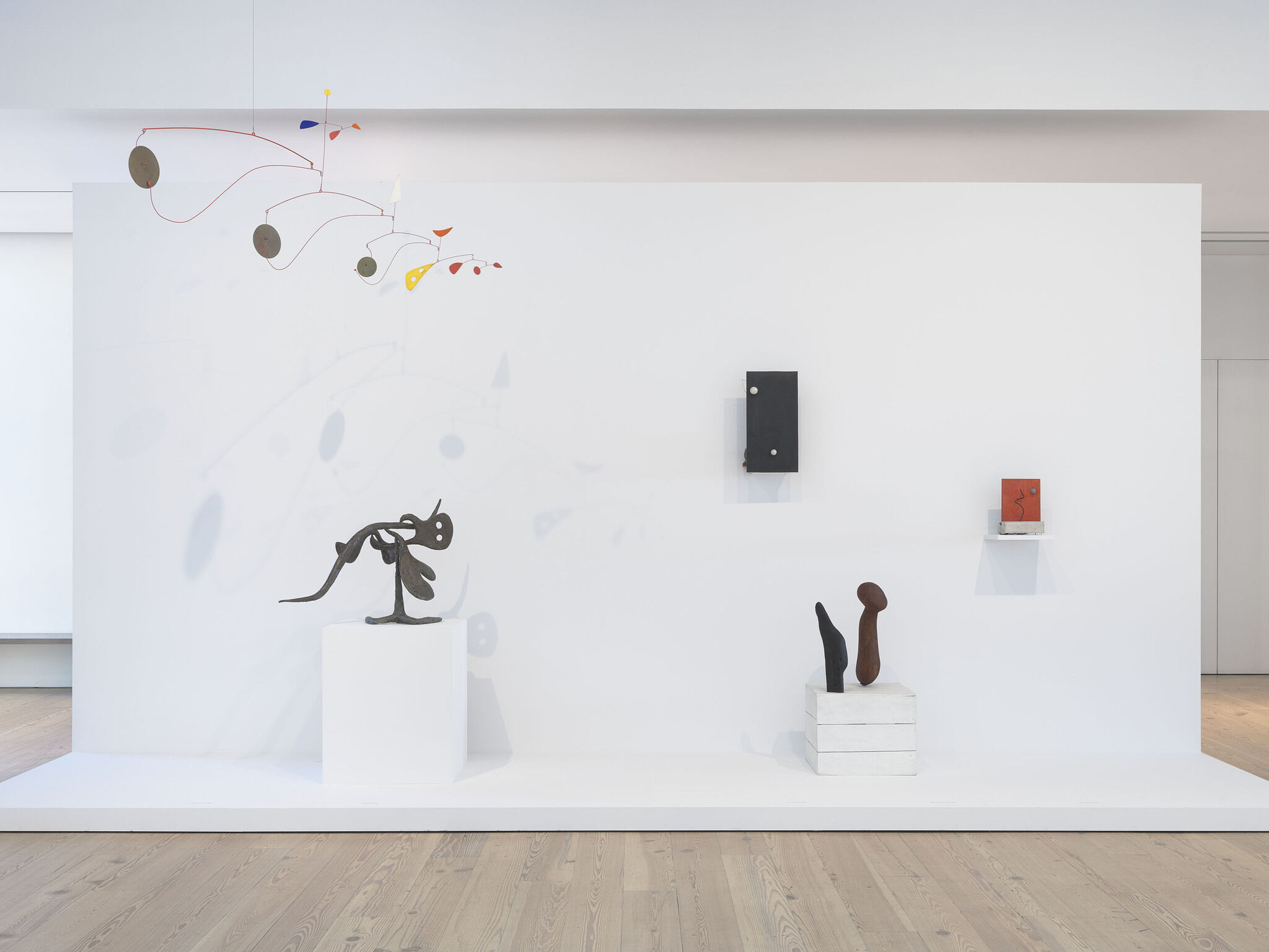

Installation view of Calder: Hypermobility (Whitney Museum of American Art, New York, June 9-October 23, 2017). Clockwise beginning from top left: Alexander Calder, Triple Gong, 1948, Calder Foundation, New York, promised gift of Holton Rower; Alexander Calder, Two Spheres, 1931, Calder Foundation, New York, promised gift of Holton Rower; Alexander Calder, Red Panel, c. 1934, Calder Foundation, New York, promised gift of Alexander S. C. Rower; Alexander Calder, Machine motorisée, 1933, Calder Foundation, New York; Alexander Calder, Octopus, 1944, Havard Art Museums/Fogg Museum, Cambridge, Massachusetts, gift of Lois Orswell ©2017 Calder Foundation, New York/ Artists Rights Society (ARS), New York, N.Y. Photograph Ron Amstutz
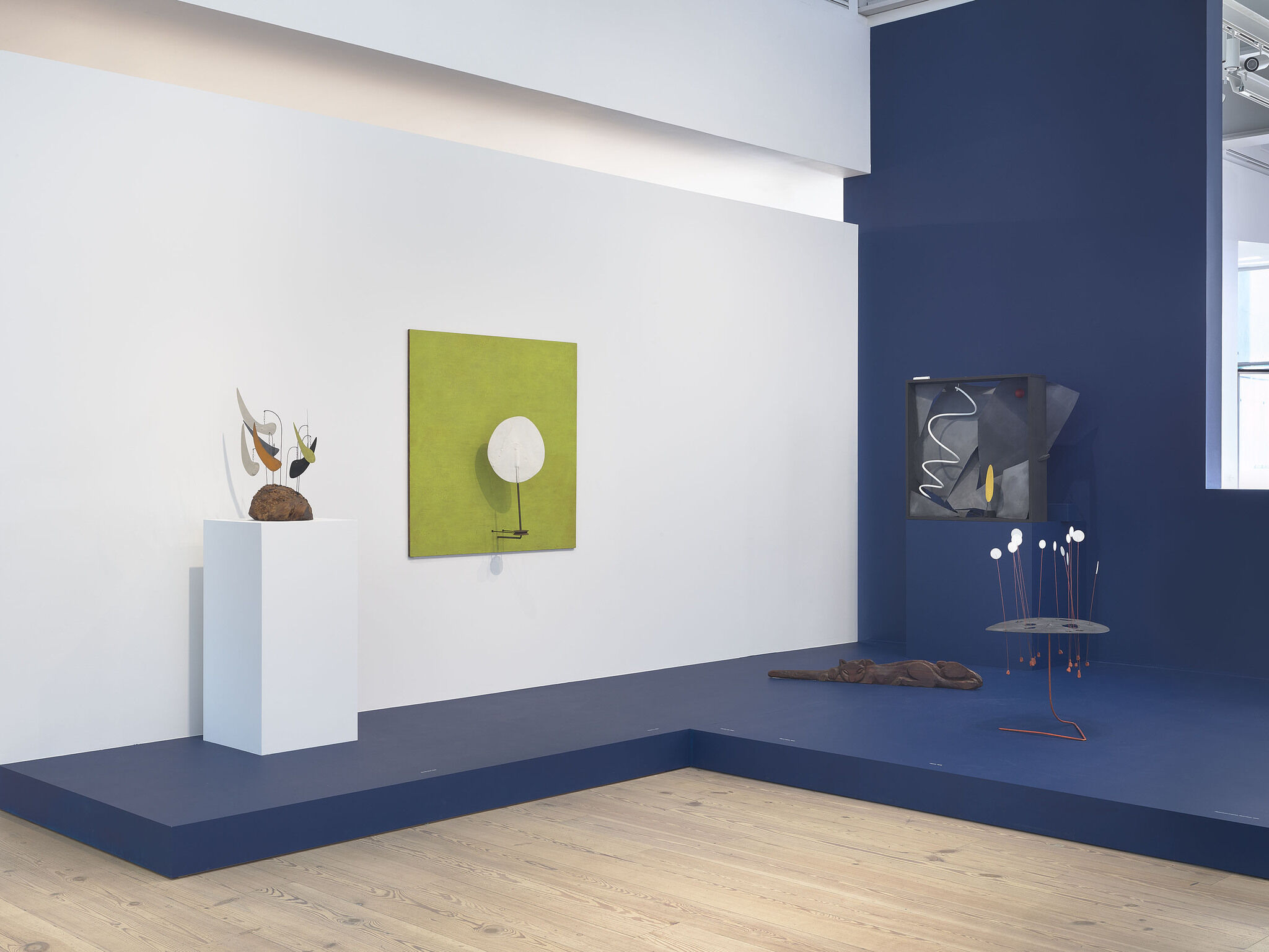

Installation view of Calder: Hypermobility (Whitney Museum of American Art, New York, June 9-October 23, 2017). From left to right: Alexander Calder, Myrtle Burl, 1941, Calder Foundation, New York, Mary Calder Rower Bequest, 2011; Alexander Calder, Square, c. 1934, Calder Foundation, New York, promised gift of Holton Rower; Alexander Calder, Double Cat, 1930, Whitney Museum of American Art, New York, purchase with funds from the Howard and Jean Lipman Foundation, Inc. 69.256; Alexander Calder, Black Frame, 1934, Calder Foundation, New York; Alexander Calder, Aspen, 1948, Calder Foundation, New York ©2017 Calder Foundation, New York/ Artists Rights Society (ARS), New York, N.Y. Photograph Ron Amstutz
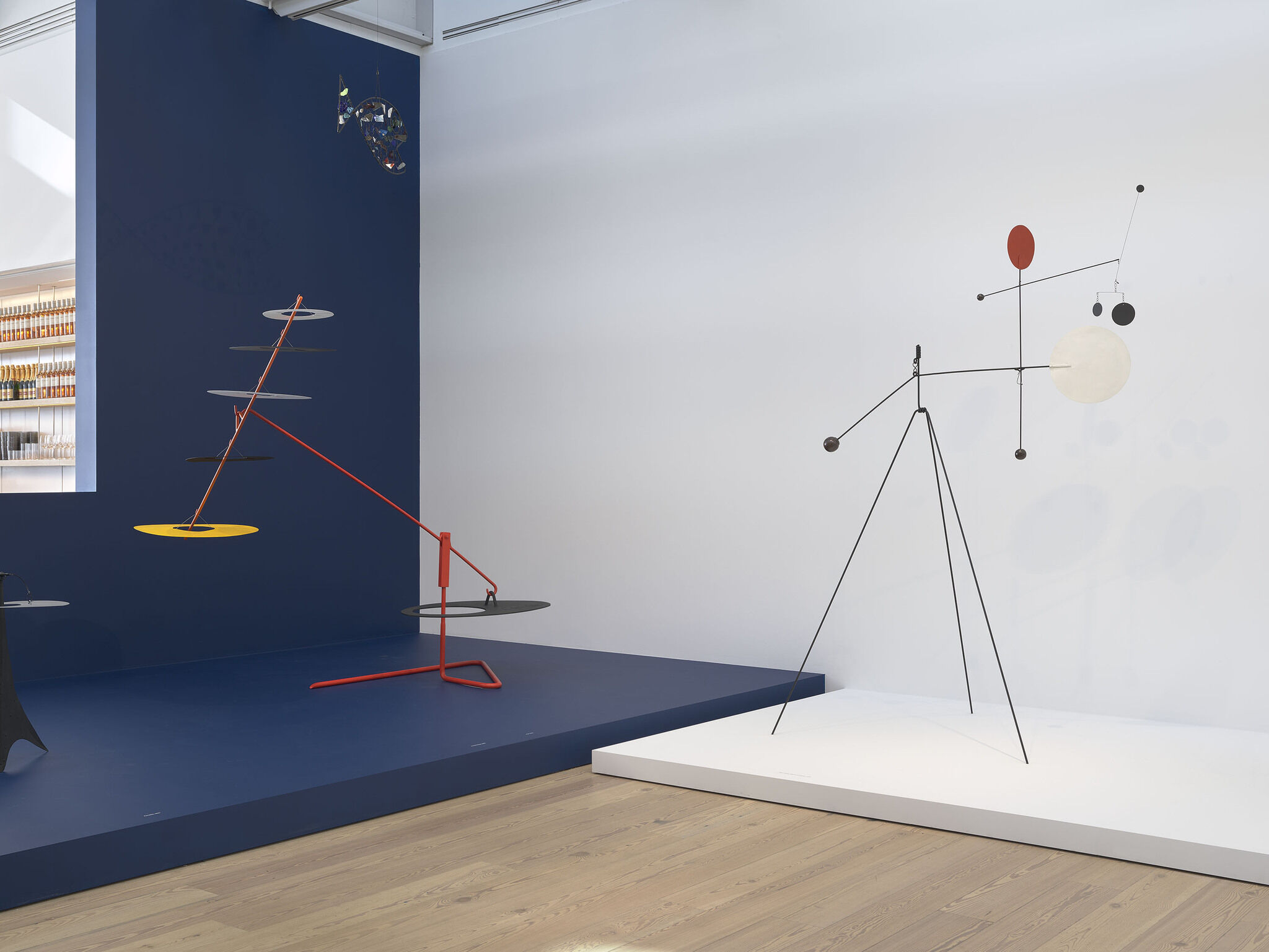

Installation view of Calder: Hypermobility (Whitney Museum of American Art, New York, June 9-October 23, 2017). From left to right: Alexander Calder, Parasite, 1947, Calder Foundation, New York, promised gift of Holton Rower; Alexander Calder, Smoke Rings, 1968, Nahmad Collection; Alexander Calder, Fish, 1944, Whitney Museum of American Art, New York, bequest of Richard S. Zeisler 2007.82; Alexander Calder, Red, White, Black and Brass, 1934, Calder Foundation, New York, promised gift of Alexander S. C. Rower ©2017 Calder Foundation, New York/ Artists Rights Society (ARS), New York, N.Y. Photograph Ron Amstutz
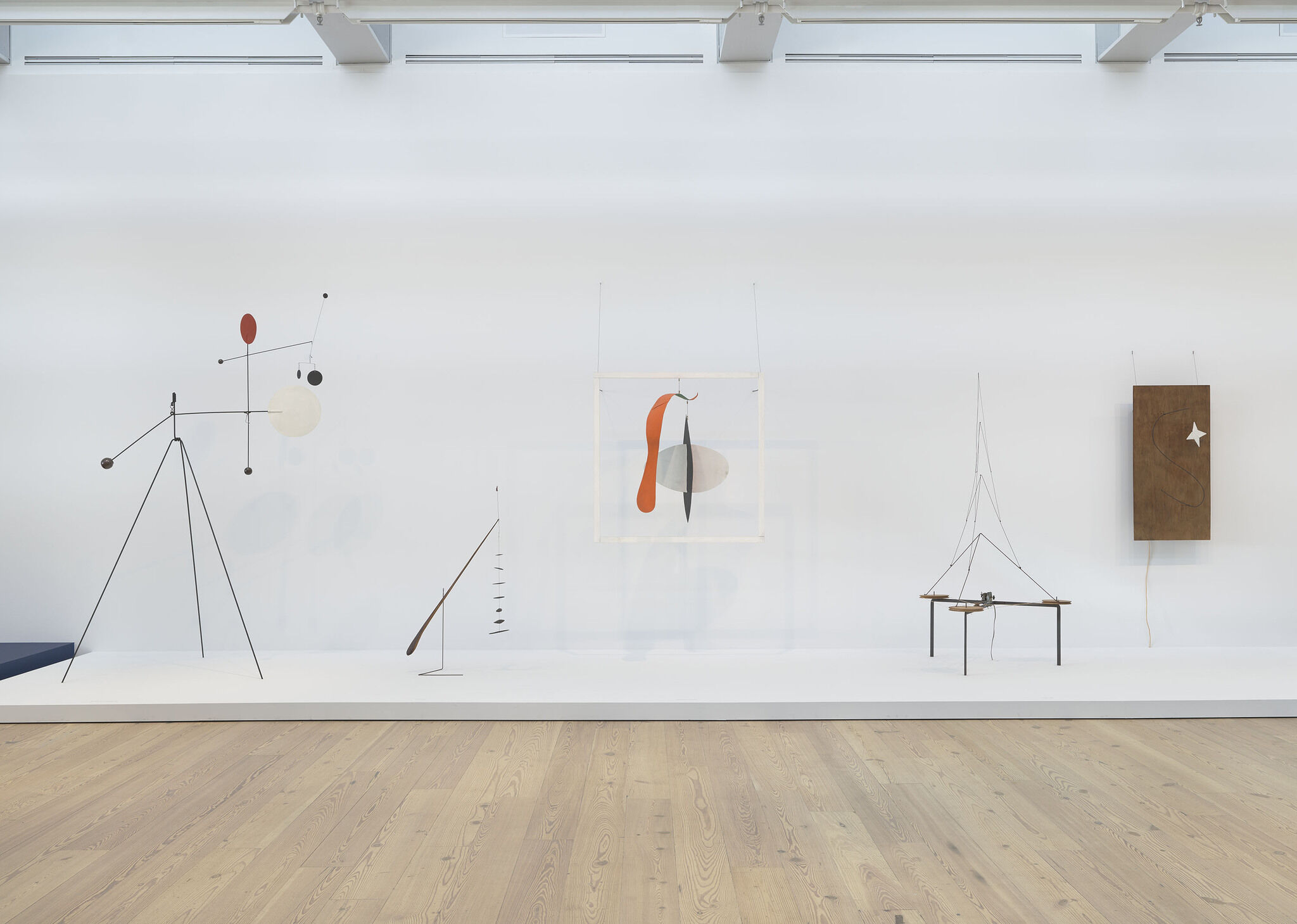

Installation view of Calder: Hypermobility (Whitney Museum of American Art, New York, June 9-October 23, 2017). From left to right: Alexander Calder, Red, White, Black and Brass, 1934, Calder Foundation, promised gift of Alexander S. C. Rower; Alexander Calder, Untitled, 1942, Calder Foundation, New York; Alexander Calder, Snake and the Cross, 1936, Calder Foundation, New York; Alexander Calder, Untitled, 1938, Calder Foundation, New York, promised gift of Alexander S.C. Rower; Alexander Calder, S and Star, 1941, Calder Foundation, New York ©2017 Calder Foundation, New York/ Artists Rights Society (ARS), New York, N.Y. Photograph Ron Amstutz
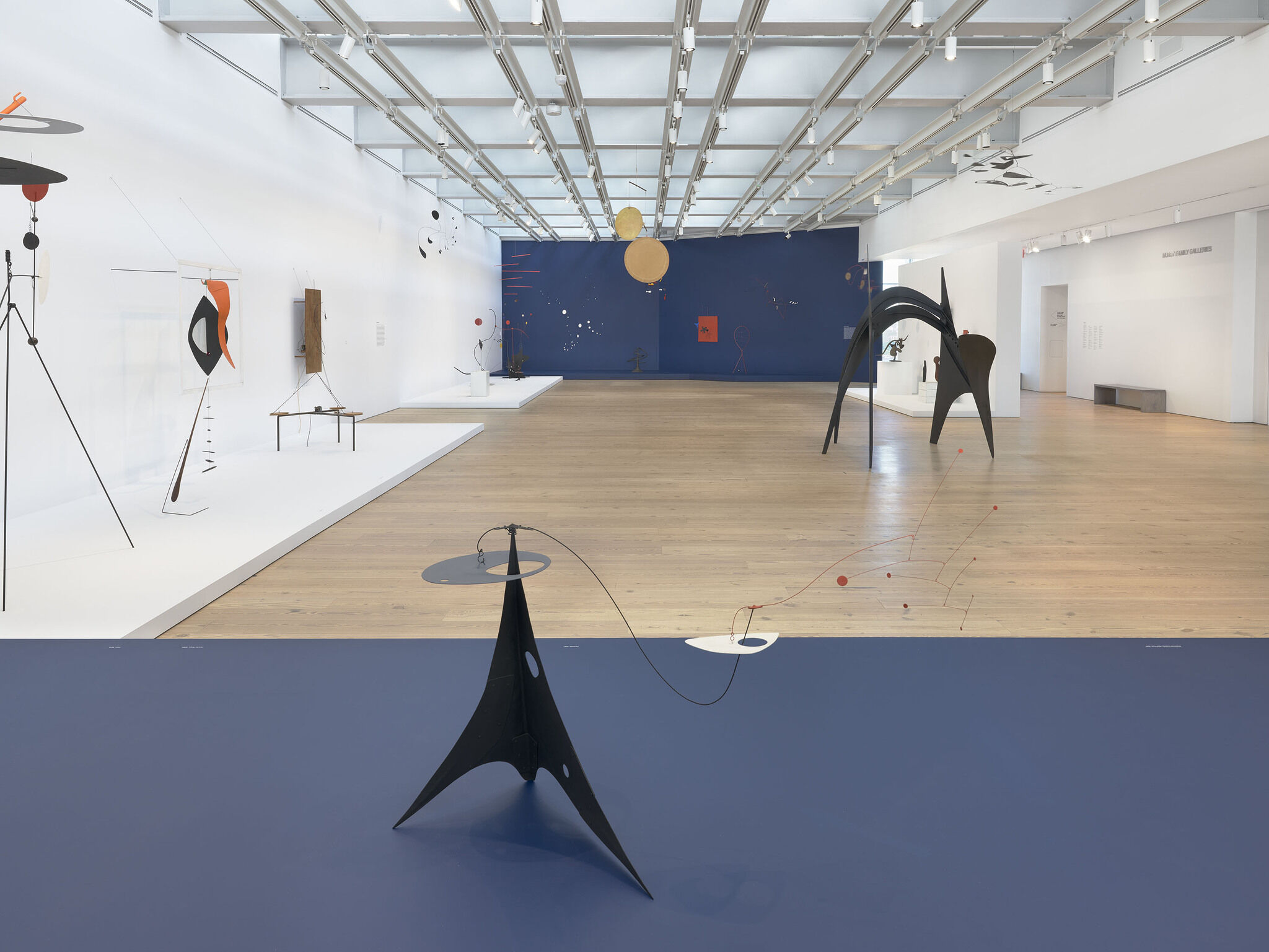

Installation view of Calder: Hypermobility (Whitney Museum of American Art, New York, June 9-October 23, 2017). Clockwise from bottom center: Alexander Calder, Parasite, 1947, Calder Foundation, New York, promised gift of Holton Rower; Alexander Calder, Smoke Rings, 1968, Nahmad Collection; Alexander Calder, Red, White, Black and Brass, 1934, Calder Foundation, New York, promised gift of Alexander S. C. Rower; Alexander Calder, Untitled, 1942, Calder Foundation, New York; Alexander Calder, Snake and the Cross, 1936, Calder Foundation, New York; Alexander Calder, Untitled, 1938, Calder Foundation, New York, promised gift of Alexander S.C. Rower; Alexander Calder, S and Star, 1941, Calder Foundation, New York; Alexander Calder, Hanging Spider, c. 1940, Whitney Museum of American Art, New York, Mrs. John B. Putnam Bequest 84.41; Alexander Calder, Half-circle, Quarter-circle, and Sphere, 1932, Whitney Museum of American Art, New York, purchase with funds from the Howard and Jean Lipman Foundation, Inc. 69.258; Alexander Calder, Whip Snake (Snake on the Post), 1944, Whitney Museum of American Art, New York, purchase with funds from the Howard and Jean Lipman Foundation, Inc. 70.3a-b; Alexander Calder, Red Sticks, c. 1943, Calder Foundation, New York; Alexander Calder, The Water Lily, c. 1945, Philadelphia Museum of Art, gift of Frances and Bayard Storey in memory of Anne d’Harnoncourt, 2013; Alexander Calder, Untitled, 1947, Calder Foundation, New York; Alexander Calder, Black Tulip, c. 1942, Collection of Irma and Norman Braman; Alexander Calder, Blizzard (Roxbury Flurry), 1946, Whitney Museum of American Art, New York, gift of Louisa Calder 77.85a-d; Alexander Calder, The Helices, 1944, Calder Foundation, New York; Alexander Calder, Sea Scape, 1947, Whitney Museum of American Art, New York, purchase with funds from the Howard and Jean Lipman Foundation, Inc. 72.121; Alexander Calder, Hour Glass, 1941, The Lipman Family Foundation, long-term loan to the Whitney Museum of American Art, New York, T.1996.8; Alexander Calder, Red Panel, 1936, Calder Foundation, New York; Alexander Calder, Bifurcated Tower, 1950, Whitney Museum of American Art, New York, purchase with funds from the Howard and Jean Lipman Foundation, Inc., and exchange 73.31a-f; Alexander Calder, Triple Gong, c. 1948, Calder Foundation, New York, promised gift of Holton Rower; Alexander Calder, Octopus, 1944, Harvard Art Museums/Fogg Museum, Cambridge, Massachusetts, gift of Lois Orswell; Alexander Calder, Machine motorisée, 1933, Calder Foundation, New York; Alexander Calder, Black Lace, c. 1947, Calder Foundation, New York; Alexander Calder, The Arches, 1959, Whitney Museum of American Art, New York, gift of Howard and Jean Lipman 82.44a-e ©2017 Calder Foundation, New York/ Artists Rights Society (ARS), New York, N.Y. Photograph Ron Amstutz
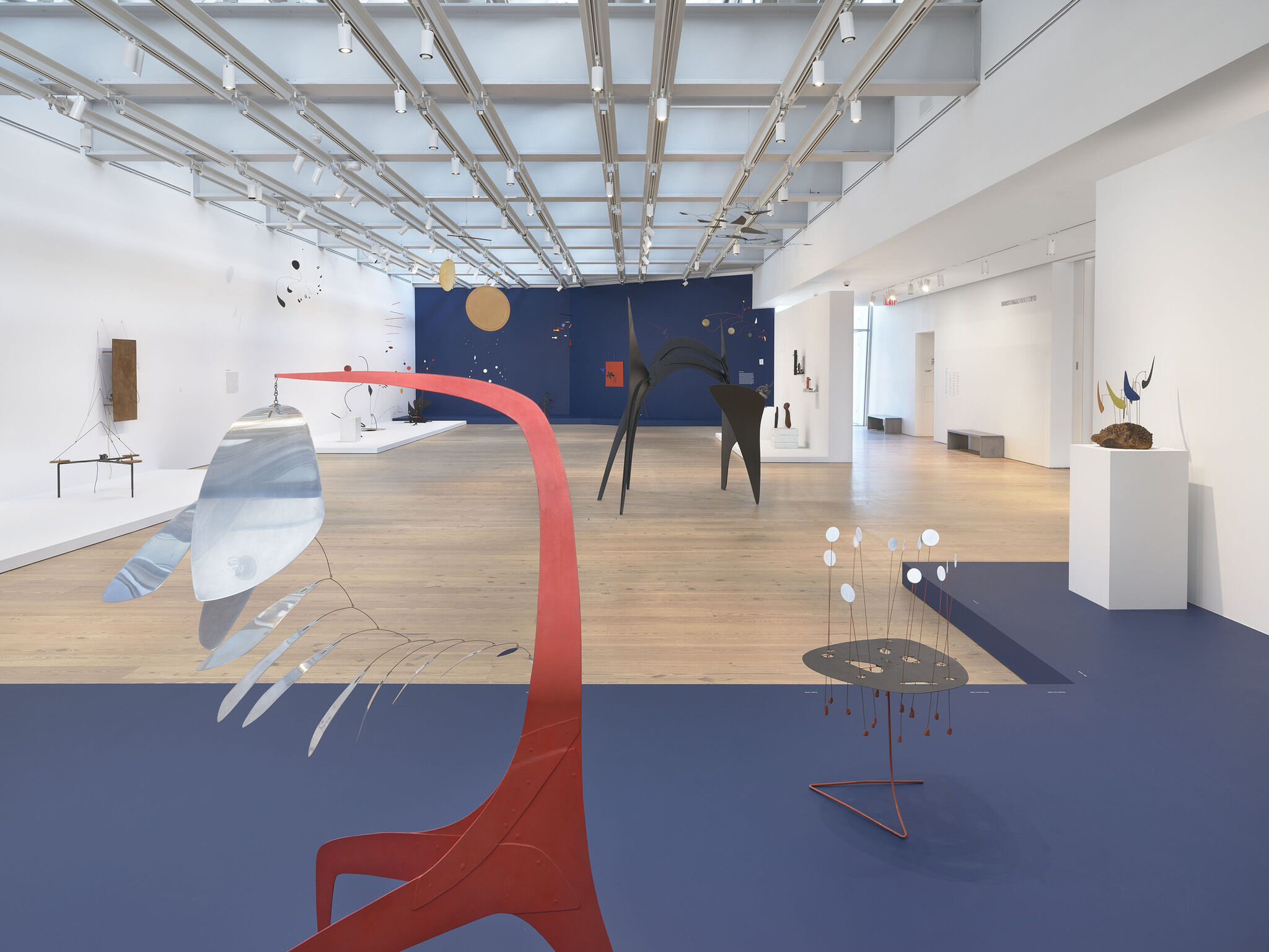

Installation view of Calder: Hypermobility (Whitney Museum of American Art, New York, June 9-October 23, 2017). Clockwise beginning from bottom left: Alexander Calder, Aluminum Leaves, Red Post, 1941, The Lipman Family Foundation, long-term loan to the Whitney Museum of American Art, New York, T.1996.7; Alexander Calder, Untitled, 1938, Calder Foundation, New York, promised gift of Alexander S. C. Rower; Alexander Calder, S and Star, 1941, Calder Foundation, New York; Alexander Calder, Hanging Spider, c. 1940, Whitney Museum of American Art, New York, Mrs. John B. Putnam Bequest 84.41; Alexander Calder, Half-circle, Quarter-circle, and Sphere, 1932, Whitney Museum of American Art, New York, purchase with funds from the Howard and Jean Lipman Foundation, Inc. 69.258; Alexander Calder, Whip Snake (Snake on the Post), 1944, Whitney Museum of American Art, New York, purchase with funds from the Howard and Jean Lipman Foundation, Inc. 70.3a-b; Alexander Calder, The Water Lily, c. 1945, Philadelphia Museum of Art, gift of Frances and Bayard Storey in memory of Anne d’Harnoncourt, 2013; Alexander Calder, Red Sticks, c. 1943, Calder Foundation, New York; Alexander Calder, Untitled, 1947, Calder Foundation, New York; Alexander Calder, Black Tulip, c. 1942, Collection of Irma and Norman Braman; Alexander Calder, Red Disc and Gong, 1940, Calder Foundation, New York, promised gift of Holton Rower; Alexander Calder, Blizzard (Roxbury Flurry), 1946, Whitney Museum of American Art, New York, gift of Louisa Calder 77.85a-d; Alexander Calder, The Helices, 1944, Calder Foundation, New York; Alexander Calder, Sea Scape, 1947, Whitney Museum of American Art, New York, purchase with funds from the Howard and Jean Lipman Foundation, Inc. 72.121; Alexander Calder, Red Panel, 1936, Calder Foundation, New York; Alexander Calder, Bifurcated Tower, 1950, Whitney Museum of American Art, New York, purchase with funds from the Howard and Jean Lipman Foundation, Inc. and exchange 73.31a-f; Alexander Calder, Triple Gong, c. 1948, Calder Foundation, New York, promised gift of Holton Rower; Alexander Calder, Two Spheres, 1931, Calder Foundation, New York, promised gift of Holton Rower; Alexander Calder, Red Panel, c. 1934, Calder Foundation, New York, promised gift of Alexander S. C. Rower; Alexander Calder, Octopus, 1944, Harvard Art Museums/Fogg Museum, Cambridge Massachusetts, gift of Lois Orswell; Alexander Calder, Machine motorisée, 1933, Calder Foundation, New York; Alexander Calder, The Arches, 1959, Whitney Museum of American Art, New York, gift of Howard and Jean Lipman 82.44a-e; Alexander Calder, Myrtle Burl, 1941, Calder Foundation, New York, Mary Calder Rower Bequest, 2011; Alexander Calder, Aspen, 1948, Calder Foundation, New York ©2017 Calder Foundation, New York/ Artists Rights Society (ARS), New York, N.Y. Photograph Ron Amstutz
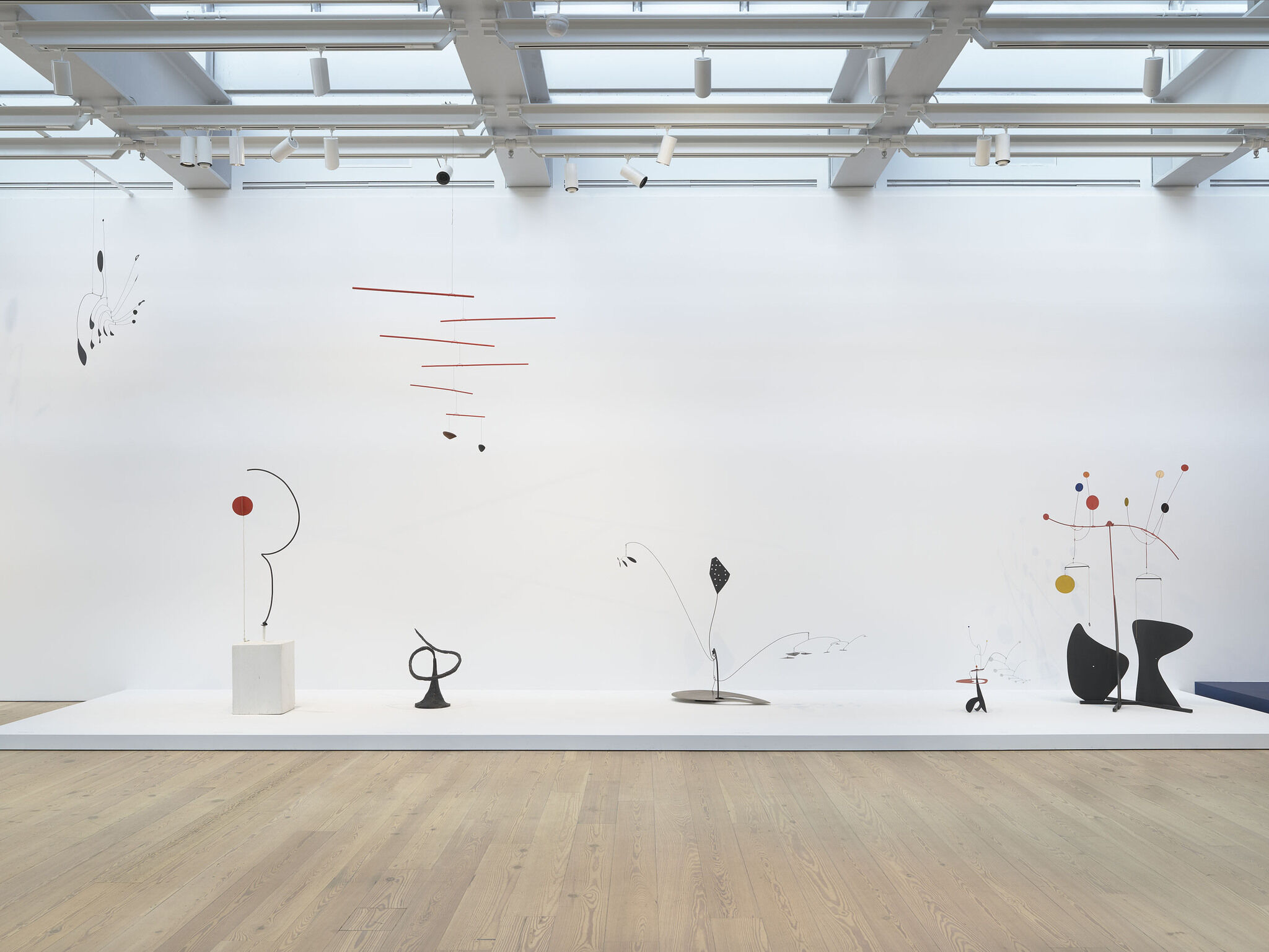

Installation view of Calder: Hypermobility (Whitney Museum of American Art, New York, June 9-October 23, 2017). Hanging from left to right: Alexander Calder, Hanging Spider, c. 1940, Whitney Museum of American Art, New York, Mrs. John B. Putnam Bequest 84.41; Alexander Calder, Red Sticks, c. 1943, Calder Foundation, New York. Standing from left to right: Alexander Calder, Half-circle, Quarter-circle, and Sphere, 1932, Whitney Museum of American Art, New York, purchase with funds from the Howard and Jean Lipman Foundation, Inc. 69.258; Alexander Calder, Whip Snake (Snake on the Post), 1944, Whitney Museum of American Art, New York, purchase with funds from the Howard and Jean Lipman Foundation, Inc. 70.3a-b; Alexander Calder, The Water Lily, c. 1945, Philadelphia Museum of Art, gift of Frances and Bayard Storey in memory of Anne d’Harnoncourt, 2013; Alexander Calder, Untitled, 1947, Calder Foundation, New York; Alexander Calder, Black Tulip, c. 1942, Collection of Irma and Norman Braman ©2017 Calder Foundation, New York/ Artists Rights Society (ARS), New York, N.Y. Photograph Ron Amstutz
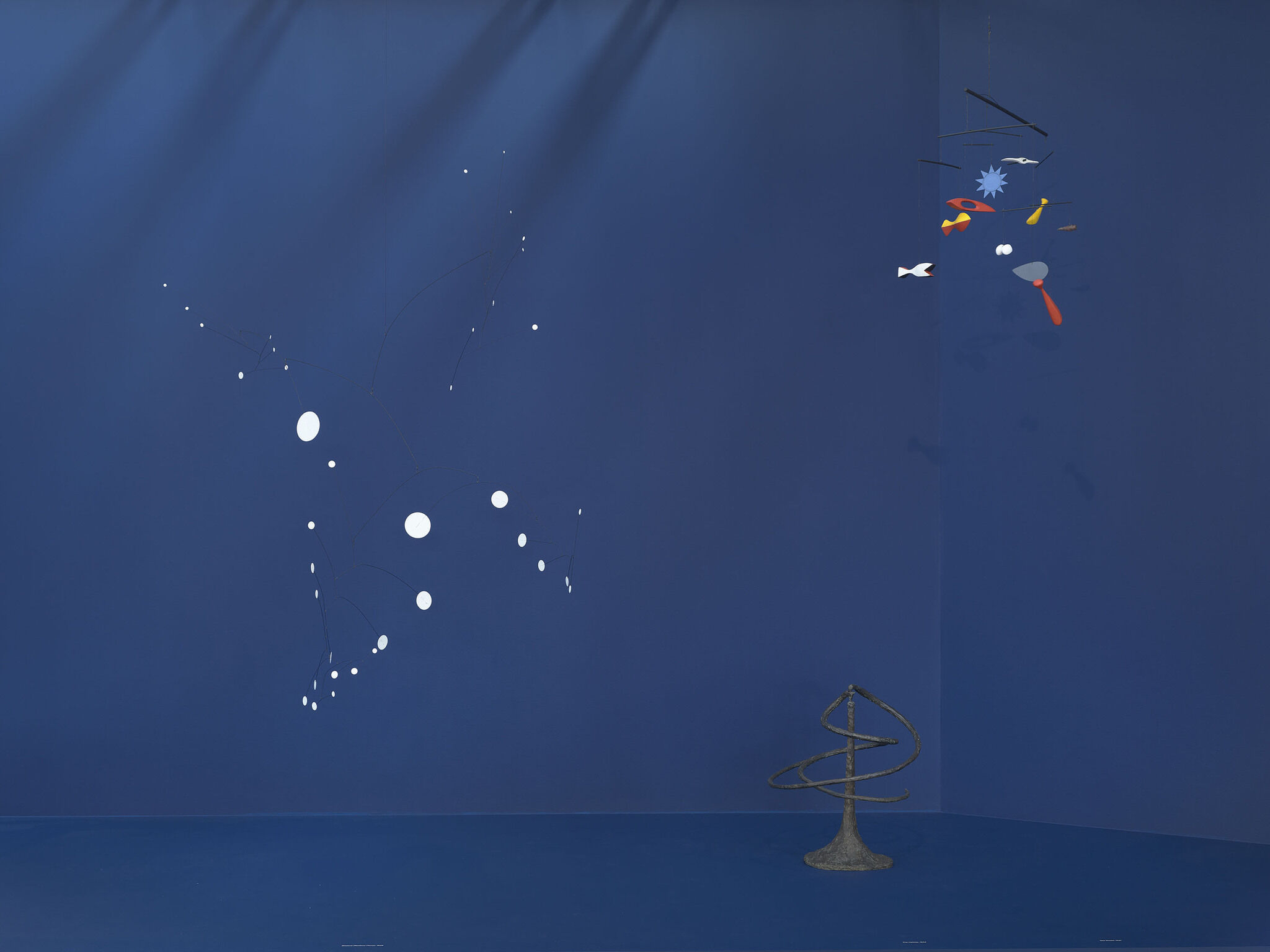

Installation view of Calder: Hypermobility (Whitney Museum of American Art, New York, June 9-October 23, 2017). From left to right: Alexander Calder, Blizzard (Roxbury Flurry), 1946, Whitney Museum of American Art, New York, gift of Louisa Calder 77.85a-d; Alexander Calder, The Helices, 1944, Calder Foundation, New York; Alexander Calder, Sea Scape, 1947, Whitney Museum of American Art, New York, purchase with funds from the Howard and Jean Lipman Foundation, Inc. 72.121 ©2017 Calder Foundation, New York/ Artists Rights Society (ARS), New York, N.Y. Photograph Ron Amstutz
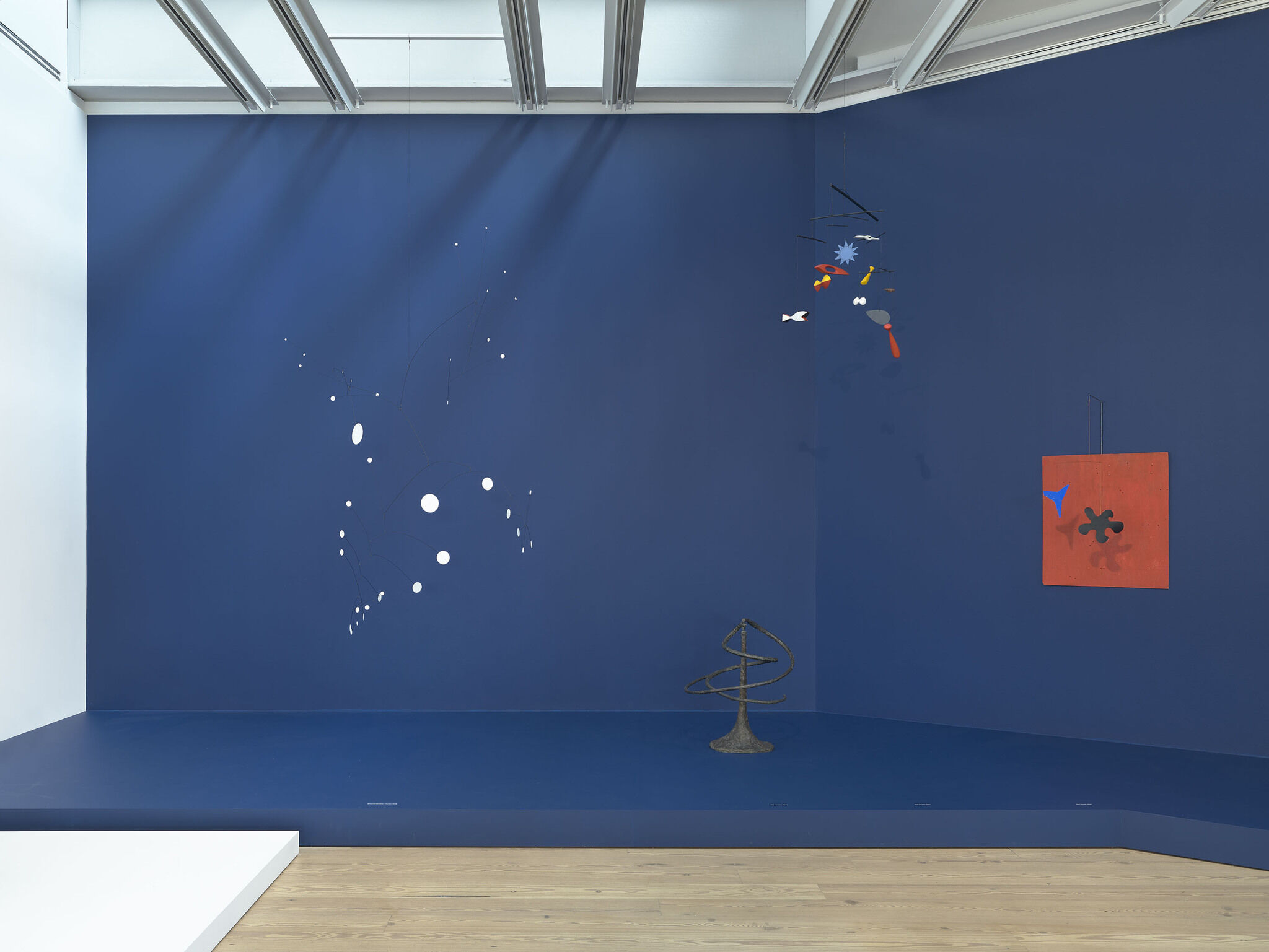

Installation view of Calder: Hypermobility (Whitney Museum of American Art, New York, June 9-October 23, 2017). From left to right: Alexander Calder, Black Tulip, c. 1942, Collection of Irma and Norman Braman; Alexander Calder, Blizzard (Roxbury Flurry), 1946, Whitney Museum of American Art, New York, gift of Louisa Calder; Alexander Calder, The Helices, 1944, Calder Foundation, New York; Alexander Calder, Sea Scape, 1947, Whitney Museum of American Art, New York, purchase with funds from the Howard and Jean Lipman Foundation, Inc. 72.121; Alexander Calder, Red Panel, 1936, Calder Foundation, New York ©2017 Calder Foundation, New York/ Artists Rights Society (ARS), New York, N.Y. Photograph Ron Amstutz
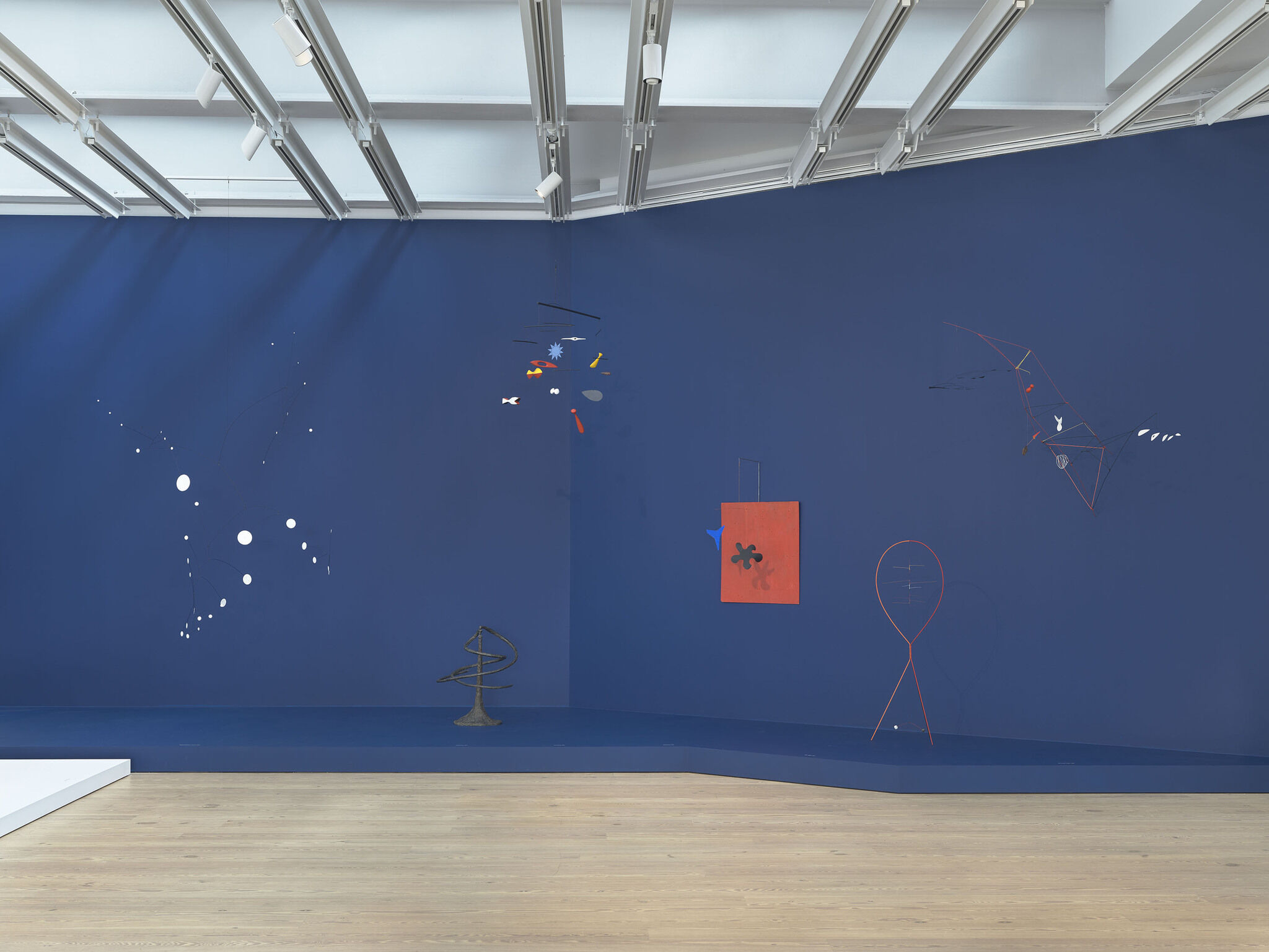

Installation view of Calder: Hypermobility (Whitney Museum of American Art, New York, June 9-October 23, 2017). From left to right: Alexander Calder, Blizzard (Roxbury Flurry), 1946, Whitney Museum of American Art, New York, gift of Louisa Calder 77.85a-d; Alexander Calder, The Helices, 1944, Calder Foundation, New York; Alexander Calder, Sea Scape, 1947, Whitney Museum of American Art, New York, purchase with funds from the Howard and Jean Lipman Foundation, Inc. 72.121; Alexander Calder, Hour Glass, 1941, The Lipman Family Foundation, long-term loan to the Whitney Museum of American Art, New York, T.1996.8; Alexander Calder, Red Panel, 1936, Calder Foundation, New York; Alexander Calder, Bifurcated Tower, 1950, Whitney Museum of American Art, New York, purchase with funds from the Howard and Jean Lipman Foundation, Inc. and exchange 73.31a-f ©2017 Calder Foundation, New York/ Artists Rights Society (ARS), New York, N.Y. Photograph Ron Amstutz
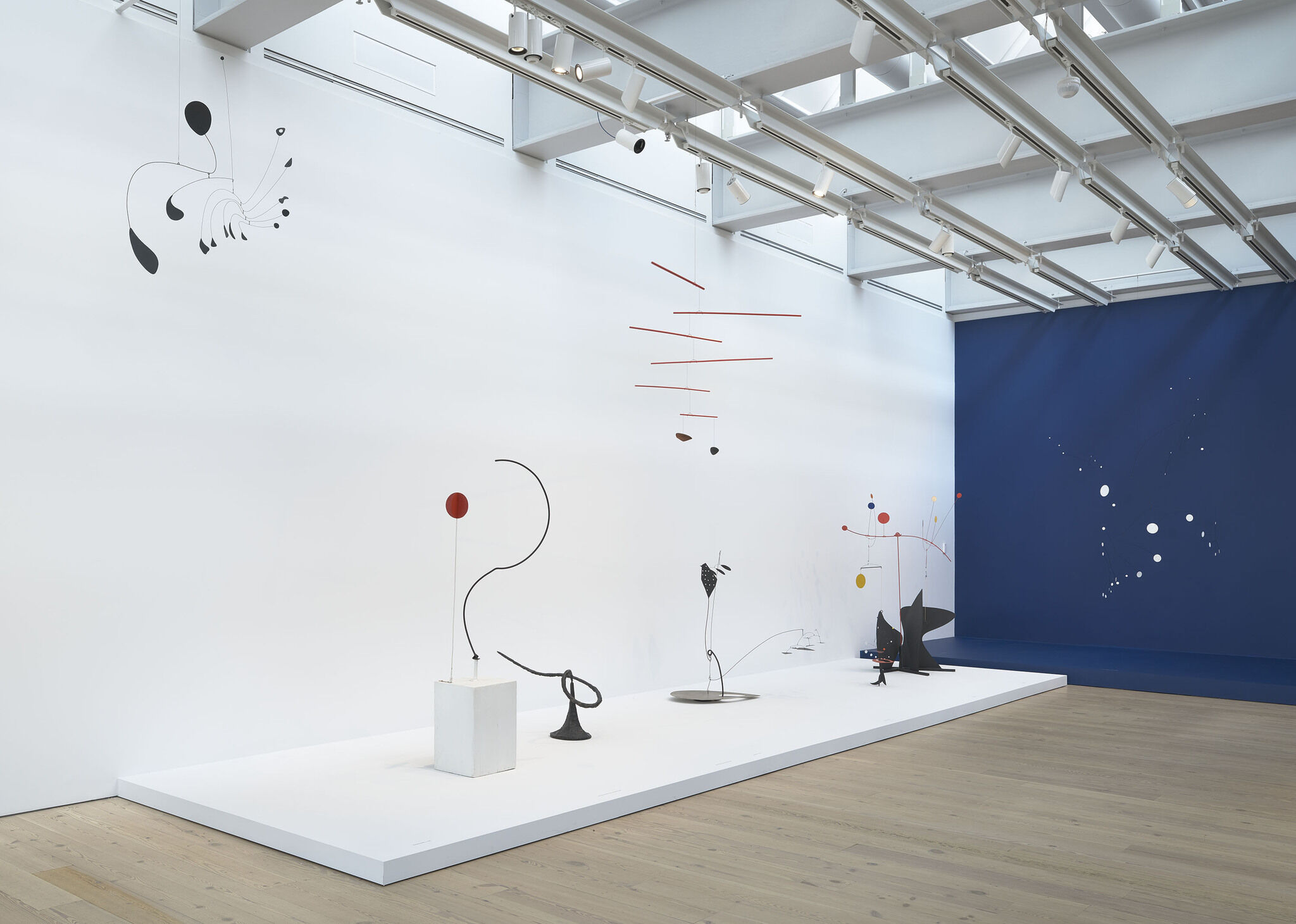

Installation view of Calder: Hypermobility (Whitney Museum of American Art, New York, June 9-October 23, 2017). From left to right: Alexander Calder, Hanging Spider, c. 1940, Whitney Museum of American Art, New York, Mrs. John B. Putnam Bequest 84.41; Alexander Calder, Half-circle, Quarter-circle, and Sphere, 1932, Whitney Museum of American Art, New York, purchase with funds from the Howard and Jean Lipman Foundation, Inc. 69.258; Alexander Calder, Whip Snake (Snake on the Post), 1944, Whitney Museum of American Art, New York, purchase with funds from the Howard and Jean Lipman Foundation, Inc. 70.3a-b; Alexander Calder, Red Sticks, c. 1943, Calder Foundation, New York; Alexander Calder, The Water Lily, c. 1945, Philadelphia Museum of Art, gift of Frances and Bayard Storey in memory of Anne d’Harnoncourt, 2013; Alexander Calder, Untitled, 1947, Calder Foundation, New York; Alexander Calder, Black Tulip, c. 1942, Collection of Irma and Norman Braman; Alexander Calder, Blizzard (Roxbury Flurry), 1946, Whitney Museum of American Art, New York, gift of Louisa Calder 77.85a-d ©2017 Calder Foundation, New York/ Artists Rights Society (ARS), New York, N.Y. Photograph Ron Amstutz
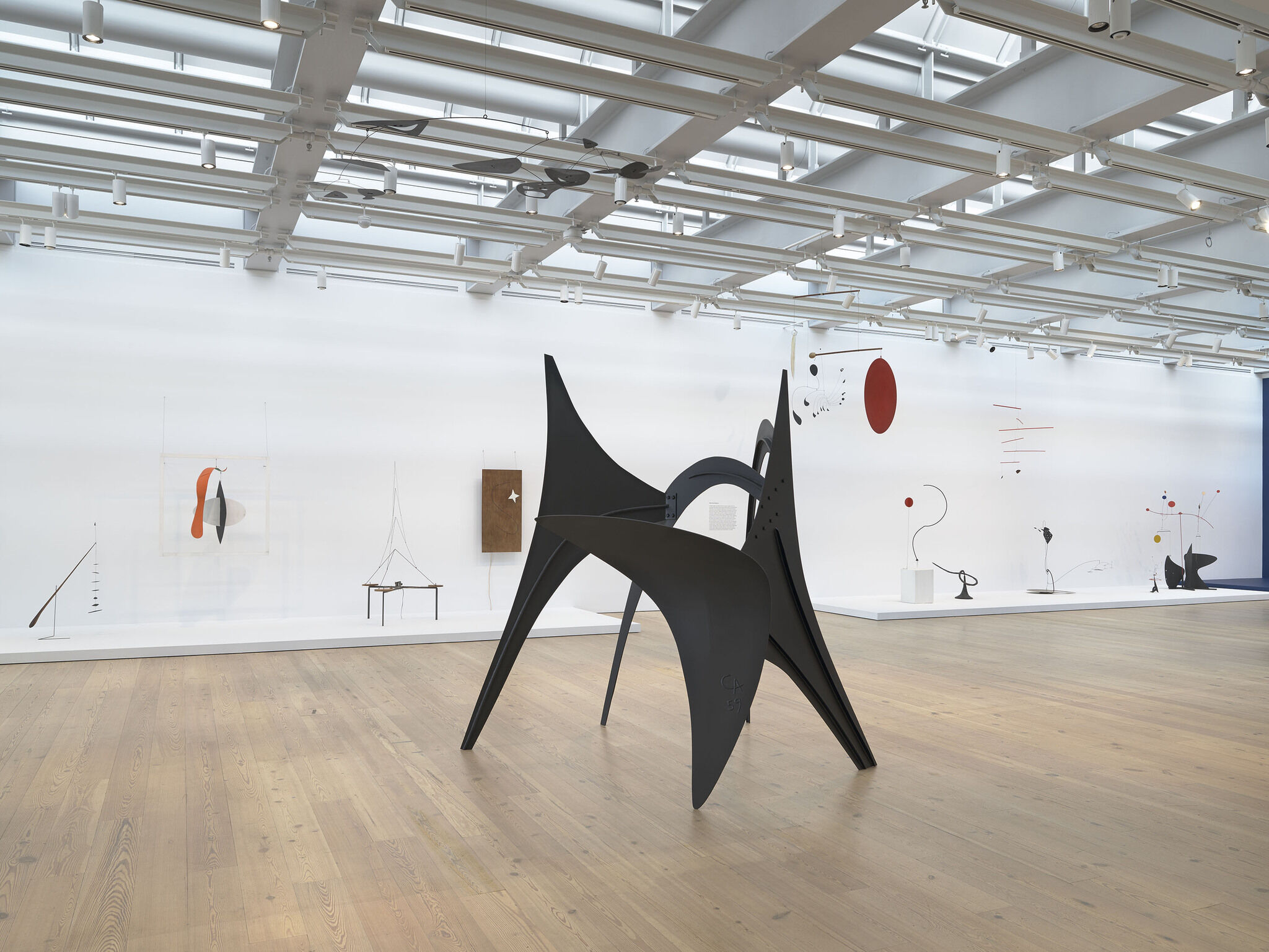

Installation view of Calder: Hypermobility (Whitney Museum of American Art, New York, June 9-October 23, 2017). From left to right: Alexander Calder, Untitled, 1942, Calder Foundation, New York ; Alexander Calder, Snake and the Cross, 1936, Calder Foundation, New York; Alexander Calder, Untitled, 1938, Calder Foundation, New York, promised gift of Alexander S. C. Rower; Alexander Calder, S and Star, 1941, Calder Foundation, New York; Alexander Calder, The Arches, 1959, Whitney Museum of American Art, New York, gift of Howard and Jean Lipman 82.44a-e; Alexander Calder, Hanging Spider, c. 1940, Whitney Museum of American Art, New York, Mrs. John B. Putnam Bequest 84.41; Alexander Calder, Red Disc and Gong, 1940, Calder Foundation, New York, promised gift of Holton Rower; Alexander Calder, Half-circle, Quarter-circle, and Sphere, 1932, Whitney Museum of American Art, New York, purchase with funds from the Howard and Jean Lipman Foundation, Inc. 69.258; Alexander Calder, Whip Snake (Snake on the Post), 1944, Whitney Museum of American Art, New York, purchase with funds from the Howard and Jean Lipman Foundation, Inc. 70.3a-b; Alexander Calder, Red Sticks, c. 1943, Calder Foundation, New York; Alexander Calder, The Water Lily, c. 1945, Philadelphia Museum of Art, gift of Frances and Bayard Storey in memory of Anne d’Harnoncourt, 2013; Alexander Calder, Untitled, 1947, Calder Foundation, New York; Alexander Calder, Black Tulip, c. 1942, Collection of Irma and Norman Braman. Hanging above center: Alexander Calder, Black Lace, c. 1947, Calder Foundation, New York ©2017 Calder Foundation, New York/ Artists Rights Society (ARS), New York, N.Y. Photograph Ron Amstutz
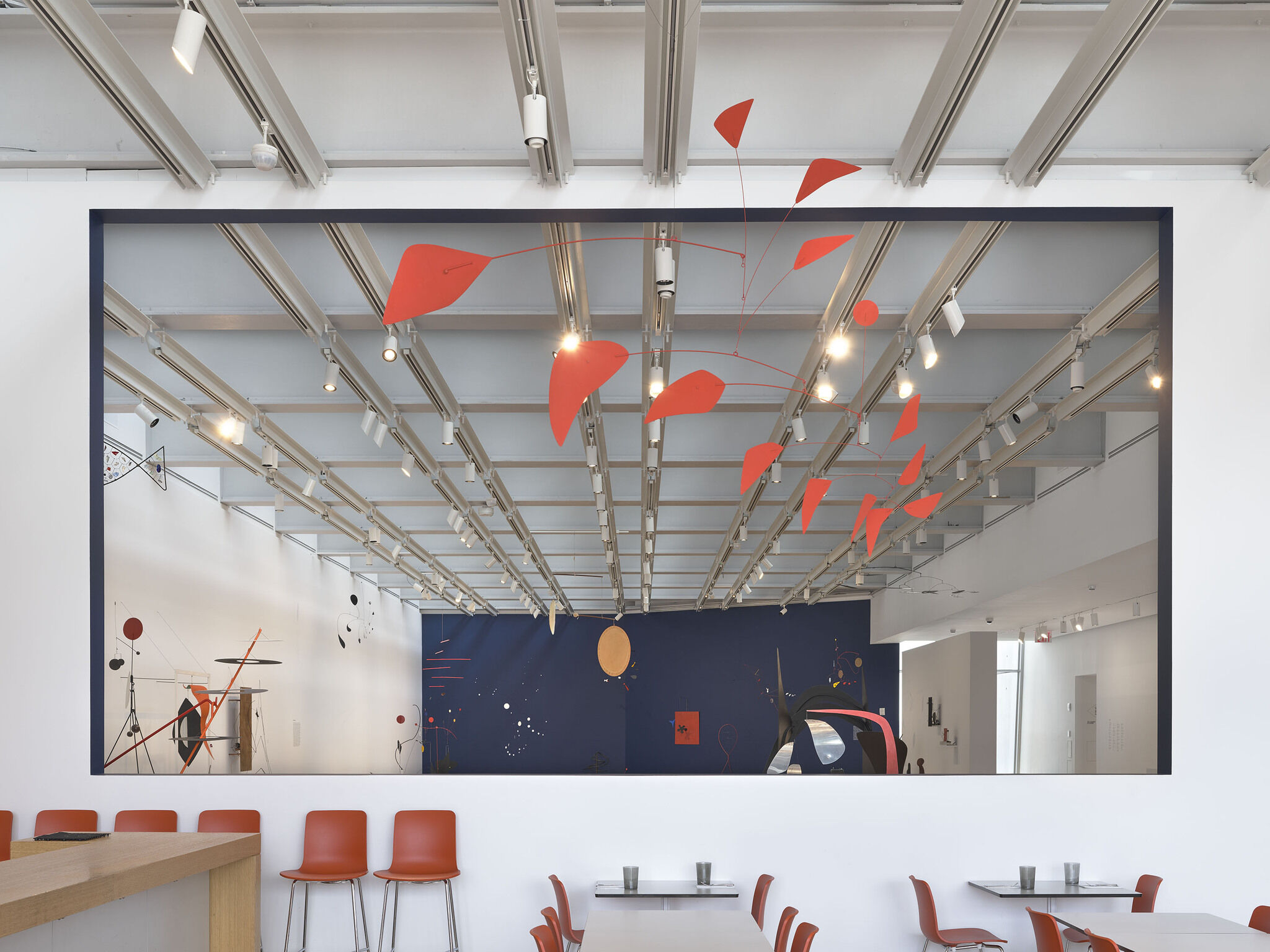

Installation view of Calder: Hypermobility (Whitney Museum of American Art, New York, June 9-October 23, 2017). Clockwise beginning top center: Alexander Calder, Big Red, 1959, Whitney Museum of American Art, New York, purchase with funds from the Friends of the Whitney Museum of American Art and by exchange 61.46a-c; Alexander Calder, Black Lace, c. 1947, Calder Foundation, New York; Alexander Calder, Triple Gong, c. 1948, Calder Foundation, New York, promised gift of Holton Rower; Alexander Calder, Two Spheres, 1931, Calder Foundation, New York, promised gift of Holton Rower; Alexander Calder, Red Panel, c. 1934, Calder Foundation, promised gift of Alexander S. C. Rower; Alexander Calder, Machine motorisée, 1933, Calder Foundation, New York; Alexander Calder, Aluminum Leaves, Red Post, 1941, The Lipman Family Foundation, long-term loan to the Whitney Museum of American Art, New York, T.1996.7; Alexander Calder, The Arches, 1959, Whitney Museum of American Art, New York, gift of Howard and Jean Lipman 82.44a-e; Alexander Calder, Bifurcated Tower, 1950, Whitney Museum of American Art, New York, purchase with funds from the Howard and Jean Lipman Foundation, Inc. and exchange 73.31a-f; Alexander Calder, Hour Glass, 1941, The Lipman Family Foundation, long-term loan to the Whitney Museum of American Art, New York, T.1996.8; Alexander Calder, Red Disc and Gong, 1940, Calder Foundation, New York, promised gift of Holton Rower; Alexander Calder, Sea Scape, 1947, Whitney Museum of American Art, New York, purchase with funds from the Howard and Jean Lipman Foundation, Inc. 72.121; Alexander Calder, The Helices, 1944, Calder Foundation, New York; Alexander Calder, Blizzard (Roxbury Flurry), 1946, Whitney Museum of American Art, New York, gift of Louisa Calder; Alexander Calder, Red Sticks, c. 1943, Calder Foundation, New York; Alexander Calder, Black Tulip, c. 1942, Collection of Irma and Norman Braman; Alexander Calder, The Water Lily, c. 1945, Philadelphia Museum of Art, gift of Frances and Bayard Storey in memory of Anne d’Harnoncourt, 2013; Alexander Calder, Half-circle, Quarter-circle, and Sphere, 1932, Whitney Museum of American Art, New York, purchase with funds from the Howard and Jeam Lipman Foundation, Inc. 69.258; Alexander Calder, Hanging Spider, c. 1940, Whitney Museum of American Art, New York, Mrs. John B. Putnam Bequest 84.41; Alexander Calder, S and Star, 1941, Calder Foundation, New York; Alexander Calder, Snake and the Cross, 1936, Calder Foundation, New York; Alexander Calder, Smoke Rings, 1968, Nahmad Collection; Alexander Calder, Red, White, Black and Brass, 1934, Calder Foundation, New York, promised gift of Alexander S.C. Rower; Alexander Calder, Fish, 1944, Whitney Museum of American Art, New York, bequest of Richard S. Zeisler 2007.82 ©2017 Calder Foundation, New York/ Artists Rights Society (ARS), New York, N.Y. Photograph Ron Amstutz
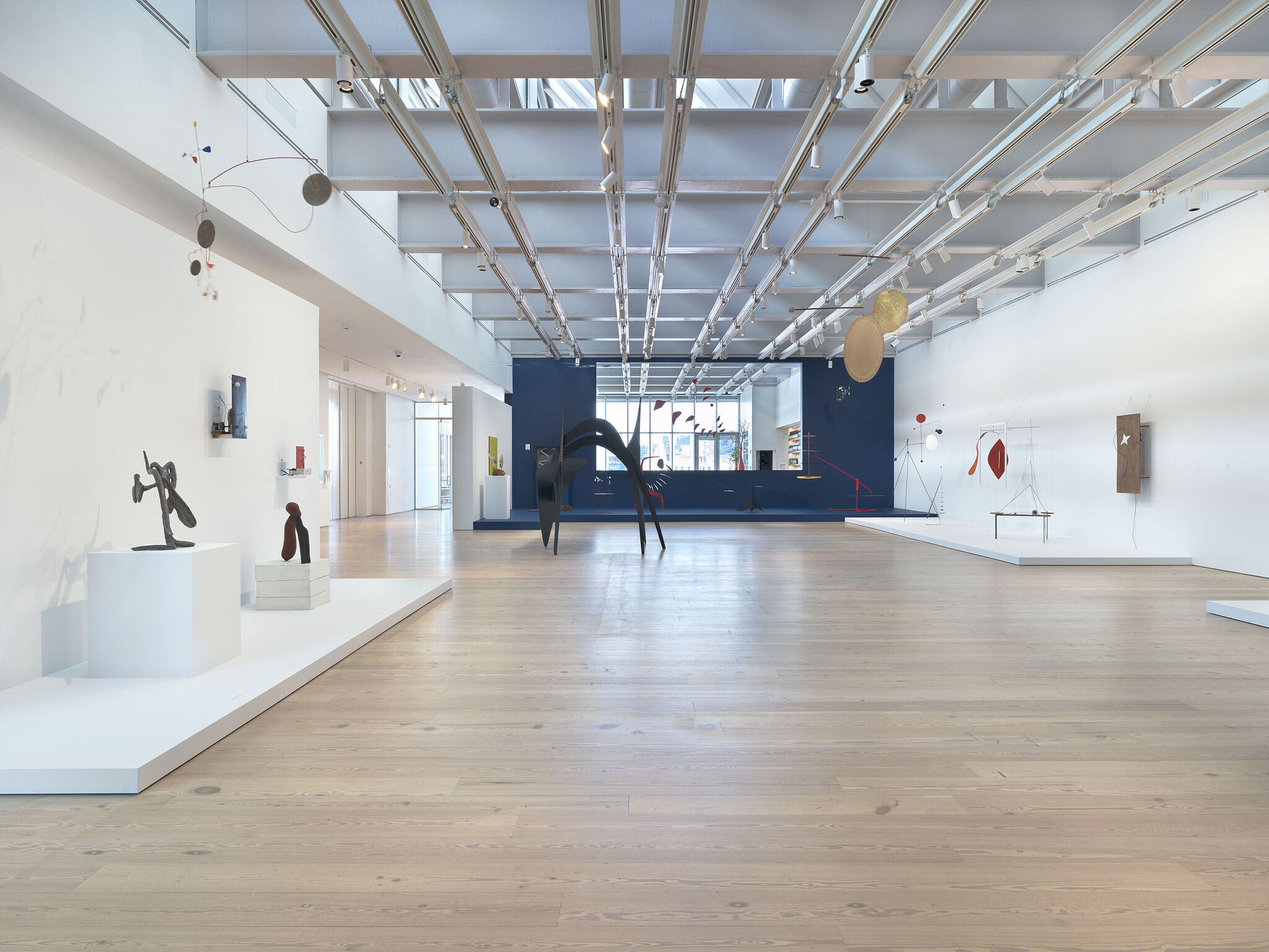

Installation view of Calder: Hypermobility (Whitney Museum of American Art, New York, June 9-October 23, 2017). Clockwise from top left: Alexander Calder, Triple Gong, c. 1948, Calder Foundation, New York, promised gift of Holton Rower; Alexander Calder, Red Disc and Gong, 1940, Calder Foundation, New York, promised gift of Holton Rower; Alexander Calder, S and Star, 1941, Calder Foundation, New York; Alexander Calder, Untitled, 1938, Calder Foundation, New York, promised gift of Alexander S. C. Rower; Alexander Calder, Snake and the Cross, 1936, Calder Foundation, New York; Alexander Calder, Untitled, 1942, Calder Foundation, New York; Alexander Calder, Red, White, Black and Brass, 1934, Calder Foundation, New York, promised gift of Alexander S. C. Rower; Alexander Calder, Fish, 1944, Whitney Museum of American Art, New York, bequest of Richard S. Zeisler 2007.82; Alexander Calder, Smoke Rings, 1968, Nahmad Collection; Alexander Calder, Parasite, 1947, Calder Foundation, New York, promised gift of Holton Rower; Alexander Calder, Big Red, 1959, Whitney Museum of American Art, New York, purchase with funds from the Friends of the Whitney Museum of American Art and by exchange 61.46a-c; Alexander Calder, Aluminum Leaves, Red Post, 1941, The Lipman Family Foundation, long-term loan to the Whitney Museum of American Art, New York; Alexander Calder, Aspen, 1948, Calder Foundation, New York; Alexander Calder, Double Cat, 1930, Whitney Museum of American Art, New York; purchase with funds from the Howard and Jean Lipman Foundation, Inc. 69.256; Alexander Calder, Square, c. 1934, Calder Foundation, New York, promised gift of Holton Rower; Alexander Calder, Myrtle Burl, 1941, Calder Foundation, New York, Mary Calder Rower Bequest, 2011; Alexander Calder, Red Panel, c. 1934, Calder Foundation, New York, promised gift of Alexander S. C. Rower; Alexander Calder, Machine motorisée, 1933, Calder Foundation, New York; Alexander Calder, Two Spheres, 1931, Calder Foundation, New York, promised gift of Holton Rower; Alexander Calder, Octopus, 1944, Harvard Art Museums/Fogg Museum, Cambridge, Massachusetts, gift of Lois Orswell ©2017 Calder Foundation, New York/ Artists Rights Society (ARS), New York, N.Y. Photograph Ron Amstutz
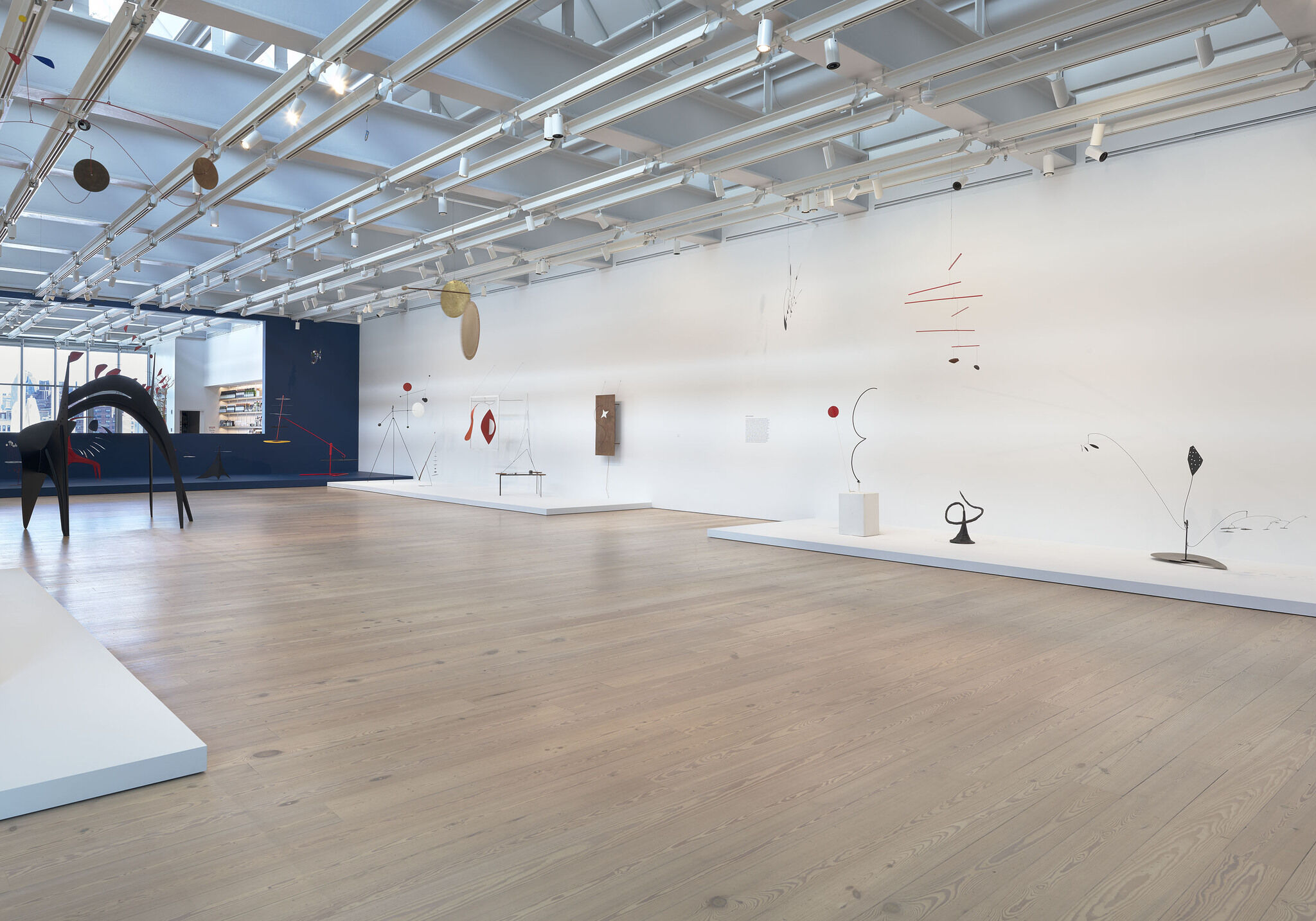

Installation view of Calder: Hypermobility (Whitney Museum of American Art, New York, June 9-October 23, 2017). Clockwise from top left corner: Alexander Calder, Triple Gong, c. 1948, Calder Foundation, New York, promised gift pf Holton Rower; Alexander Calder, The Arches, 1959, Whitney Museum of American Art, New York, gift of Howard and Jean Lipman 82.44a-e; Alexander Calder, Aspen, 1948, Calder Foundation, New York; Alexander Calder, Aluminum Leaves, Red Post, 1941, The Lipman Family foundation, long-term loan to the Whitney Museum of American Art, New York; Alexander Calder, Big Red, 1959, Whitney Museum of American Art, New York, purchase with funds from the Friends of the Whitney Museum of American Art and by exchange 61.46a-c; Alexander Calder, Parasite, 1947, Calder Foundation, New York, promised gift of Holton Rower; Alexander Calder, Smoke Rings, 1968, Nahmad Collection; Alexander Calder, Fish, 1944, Whitney Museum of American Art, New York, bequest of Richard S. Zeisler 2007.82; Alexander Calder, Red White Black and Brass, 1934, Calder Foundation, New York, promised gift of Alexander S.C. Rower; Alexander Calder, Untitled, 1942, Calder Foundation, New York; Alexander Calder, Snake and the Cross, 1936, Calder Foundation, New York; Alexander Calder, Untitled, 1938, Calder Foundation, New York, promised gift of Alexander S. C. Rower; Alexander Calder, S and Star, 1941, Calder Foundation, New York; Alexander Calder, Hanging Spider, c. 1940, Whitney Museum of American Art, New York, Mrs. John B. Putnam Bequest 84.41; Alexander Calder, Half-circle, Quart-circle, and Sphere, 1932, Whitney Museum of American Art, New York, purchase with funds from the Howard and Jean Lipman Foundation, Inc. 70.3a-b; Alexander Calder, Red Sticks, c. 1943, Calder Foundation, New York; Alexander Calder, Whip Snake (Snake on the Post), 1944, Whitney Museum of American Art, New York, purchase with funds from the Howard and Jean Lipman Foundation, Inc. 70.3a-b; Alexander Calder, The Water Lily, c. 1945, Philadelphia Museum of Art, gift of Frances and Bayard Storey in memory of Anne d’Harnoncourt, 2013 ©2017 Calder Foundation, New York/ Artists Rights Society (ARS), New York, N.Y. Photograph Ron Amstutz
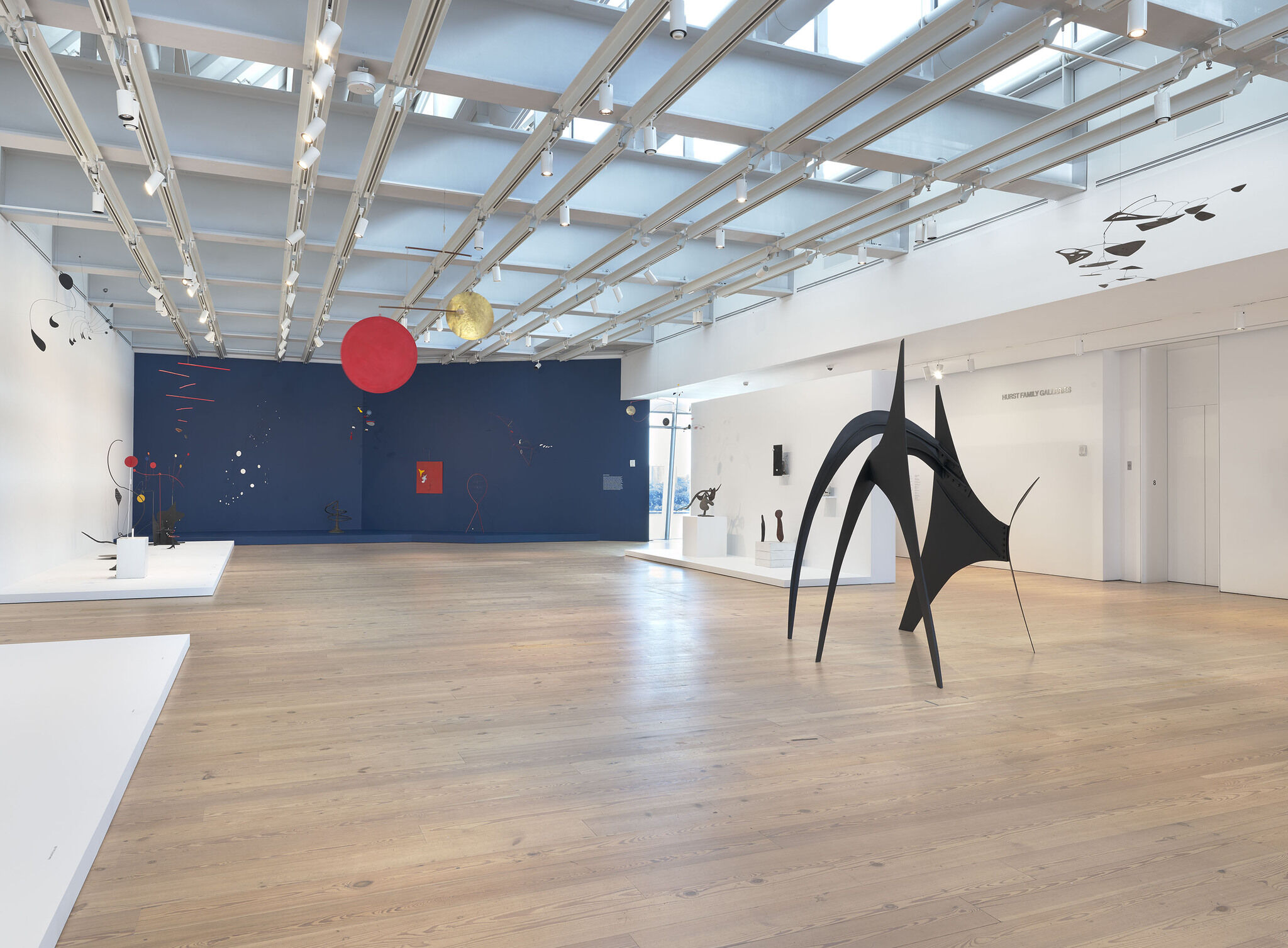

Installation view of Calder: Hypermobility (Whitney Museum of American Art, New York, June 9-October 23, 2017). Clockwise beginning in top right corner: Alexander Calder, Black Lace, c. 1947, Calder Foundation, New York; Alexander Calder, The Arches, 1959, Calder Foundation, New York; Alexander Calder, Red Disc and Gong, 1940, Calder Foundation, New York, promised gift of Holton Rower; Alexander Calder, Hanging Spider, c. 1940, Whitney Museum of American Art, New York, Mrs. John B. Putnam Bequest 84.41; Alexander Calder, Half-circle, Quarter-circle, and Sphere, 1932, Whitney Museum of American Art, New York, purchase with funds from the Howard and Jean Lipman Foundation, Inc. 69.258; Alexander Calder, The Water Lily, c. 1945, Philadelphia Museum of Art, gift of Frances and Bayard Storey in memory of Anne d’Harnoncourt, 2013; Alexander Calder, Untitled, 1947, Calder Foundation, New York; Alexander Calder, Black Tulip, c. 1942, Collection of Irma and Norman Braman; Alexander Calder, Red Sticks, c. 1943, Calder Foundation, New York; Alexander Calder, Blizzard (Roxbury Flurry), 1946, Whitney Museum of American Art, New York, gift of Louisa Calder 77.85a-d; Alexander Calder, The Helices, 1944, Calder Foundation, New York; Alexander Calder, Sea Scape, 1947, Whitney Museum of American Art, New York, purchase with funds from the Howard and Jean Lipman Foundation, Inc. 72.121; Alexander Calder, Red Panel, 1936, Calder Foundation, New York; Alexander Calder, Hour Glass, 1941, The Lipman Family Foundation, long term loan to the Whitney Museum of American Art, New York; Alexander Calder, Bifurcated Tower, 1950, Whitney Museum of American Art, New York, purchase with funds from the Howard and Jean Lipman Foundation, Inc. and exchange 73.31a-f; Alexander Calder, Triple Gong, c. 1948, Calder Foundation, New York, promised gift of Holton Rower; Alexander Calder, Octopus, 1944, Harvard Art Museums/Fogg Museum, Cambridge, Massachusetts, gift of Lois Orswell; Alexander Calder, Two Spheres, 1931, Calder Foundation, New York, promised gift of Holton Rower; Alexander Calder, Machine motorisée, 1933, Calder Foundation, New York, Alexander Calder, Red Panel, c. 1934, Calder Foundation, New York, promised gift of Alexander S. C. Rower ©2017 Calder Foundation, New York/ Artists Rights Society (ARS), New York, N.Y. Photograph Ron Amstutz
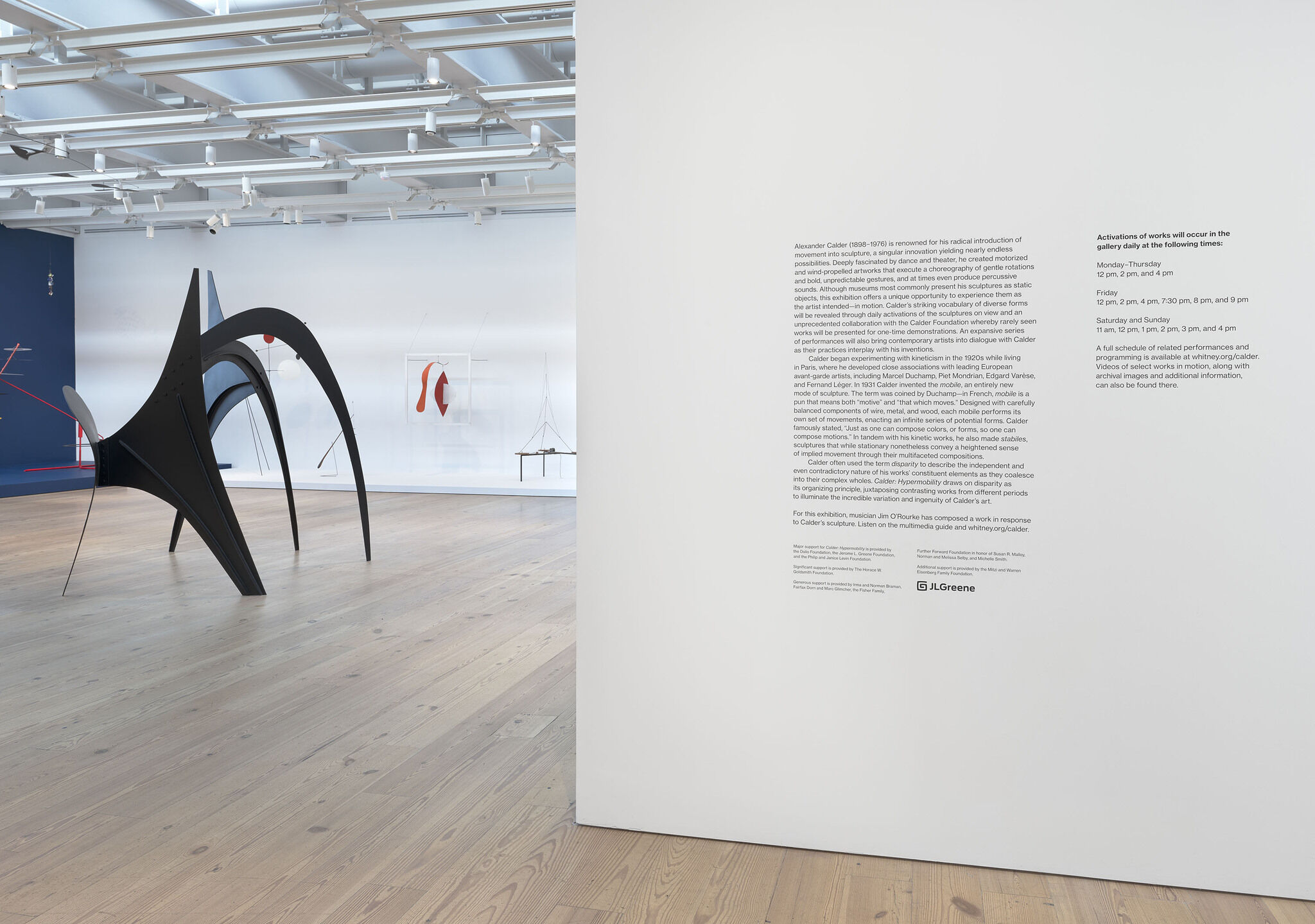

Installation view of Calder: Hypermobility (Whitney Museum of American Art, New York, June 9-October 23, 2017). Front, center: Alexander Calder, The Arches, 1959, Whitney Museum of American Art, New York, gift of Howard and Jean Lipman 82.44a-e. Back from left to right: Alexander Calder, Smoke Rings, 1968, Whitney Museum of American Art, New York, Nahmad Collection; Alexander Calder, Fish, 1944, Whitney Museum of American Art, New York, bequest of Richard S. Zeisler 2007.82; Alexander Calder, Red, White, Black and Brass, 1934, Calder Foundation, New York; Alexander Calder, Snake and the Cross, 1936, Calder Foundation, New York; Alexander Calder, Untitled, 1938, Calder Foundation, New York, promised gift of Alexander S. C. Rower ©2017 Calder Foundation, New York/ Artists Rights Society (ARS), New York, N.Y. Photograph Ron Amstutz
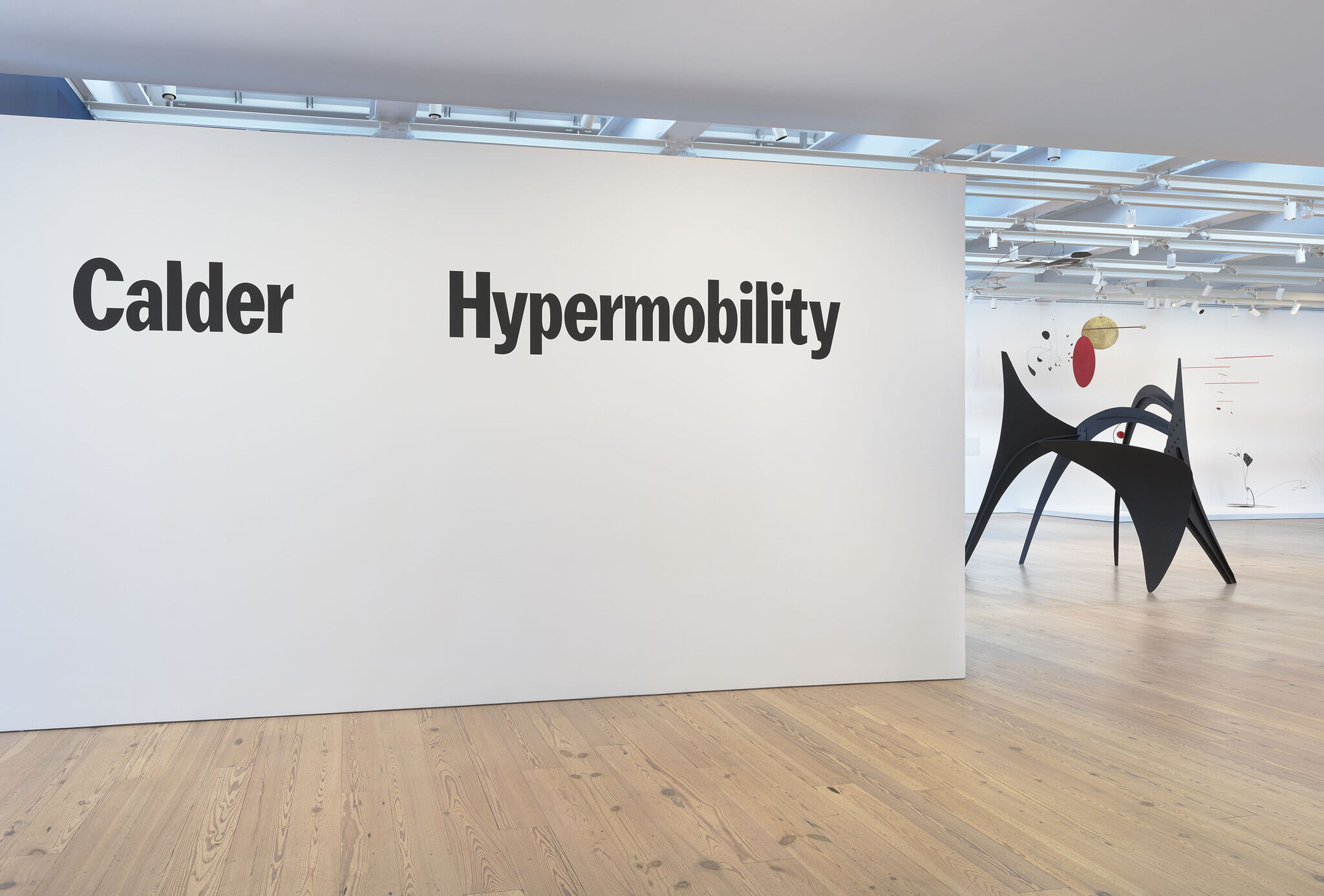

Installation view of Calder: Hypermobility (Whitney Museum of American Art, New York, June 9-October 23, 2017). From front to back, right to left: Alexander Calder, The Arches, 1959, Whitney Museum of American Art, New York, gift of Howard and Jean Lipman 82.44a-e; Alexander Calder, Black Lace, c. 1947, Calder Foundation, New York; Alexander Calder, Red Disc and Gong, 1940, Calder Foundation, New York, promised gift of Holton Rower; Alexander Calder, Hanging Spider, c. 1940, Whitney Museum of American Art, New York, Mrs. John B. Putnam Bequest 84.41; Alexander Calder, Red Sticks, c. 1943, Calder Foundation, New York; Alexander Calder, Half-circle, Quarter-circle, and Sphere, 1932, Whitney Museum of American Art, New York, purchase with funds from the Howard and Jean Lipman Foundation, Inc. 69.258; Alexander Calder, The Water Lily, c. 1945, Philadelphia Museum of Art, gift of Frances and Bayard Storey in memory of Anne d’Harnoncourt, 2013 ©2017 Calder Foundation, New York/ Artists Rights Society (ARS), New York, N.Y. Photograph Ron Amstutz
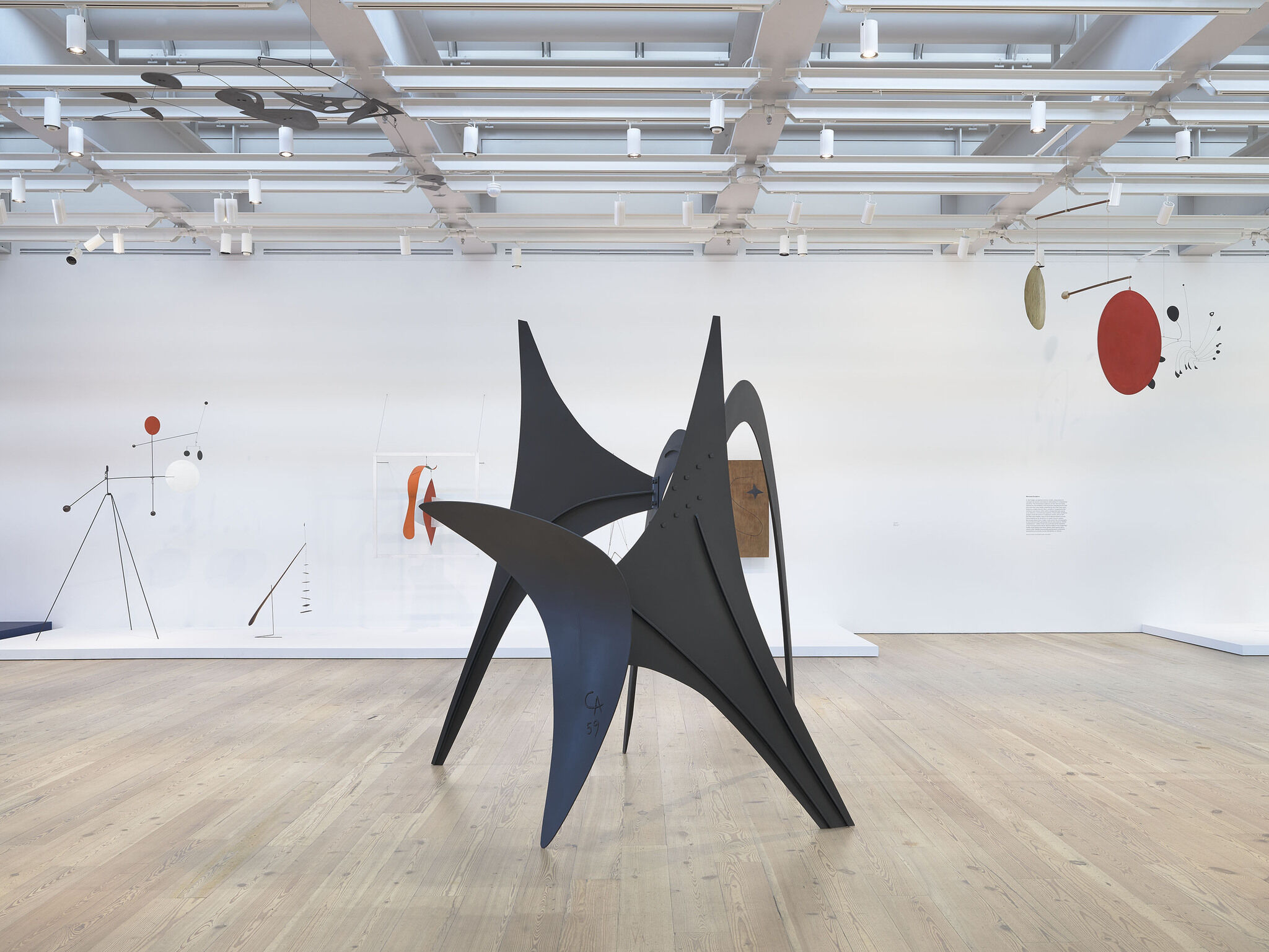

Installation view of Calder: Hypermobility (Whitney Museum of American Art, New York, June 9-October 23, 2017). Center, floor: Alexander Calder, The Arches, 1959, Whitney Museum of American Art, New York, gift of Howard and Jean Lipman 82.44a-e. Center, hanging: Alexander Calder, Black Lace, c. 1947, Calder Foundation, New York. From left to right, back: Alexander Calder, Red, White, Black and Brass, 1934, Calder Foundation, New York, promised gift of Alexander S. C. Rower; Alexander Calder, Untitled, 1942, Calder Foundation, New York; Alexander Calder, Snake and the Cross, 1936, Calder Foundation, New York; Alexander Calder, S and Star, 1941, Calder Foundation, New York; Alexander Calder, Red Disc and Gong, 1940, Calder Foundation, New York, promised gift of Holton Rower; Alexander Calder, Hanging Spider, c. 1940, Whitney Museum of American Art, New York, Mrs. John B. Putnam Bequest 84.41 ©2017 Calder Foundation, New York/ Artists Rights Society (ARS), New York, N.Y. Photograph Ron Amstutz
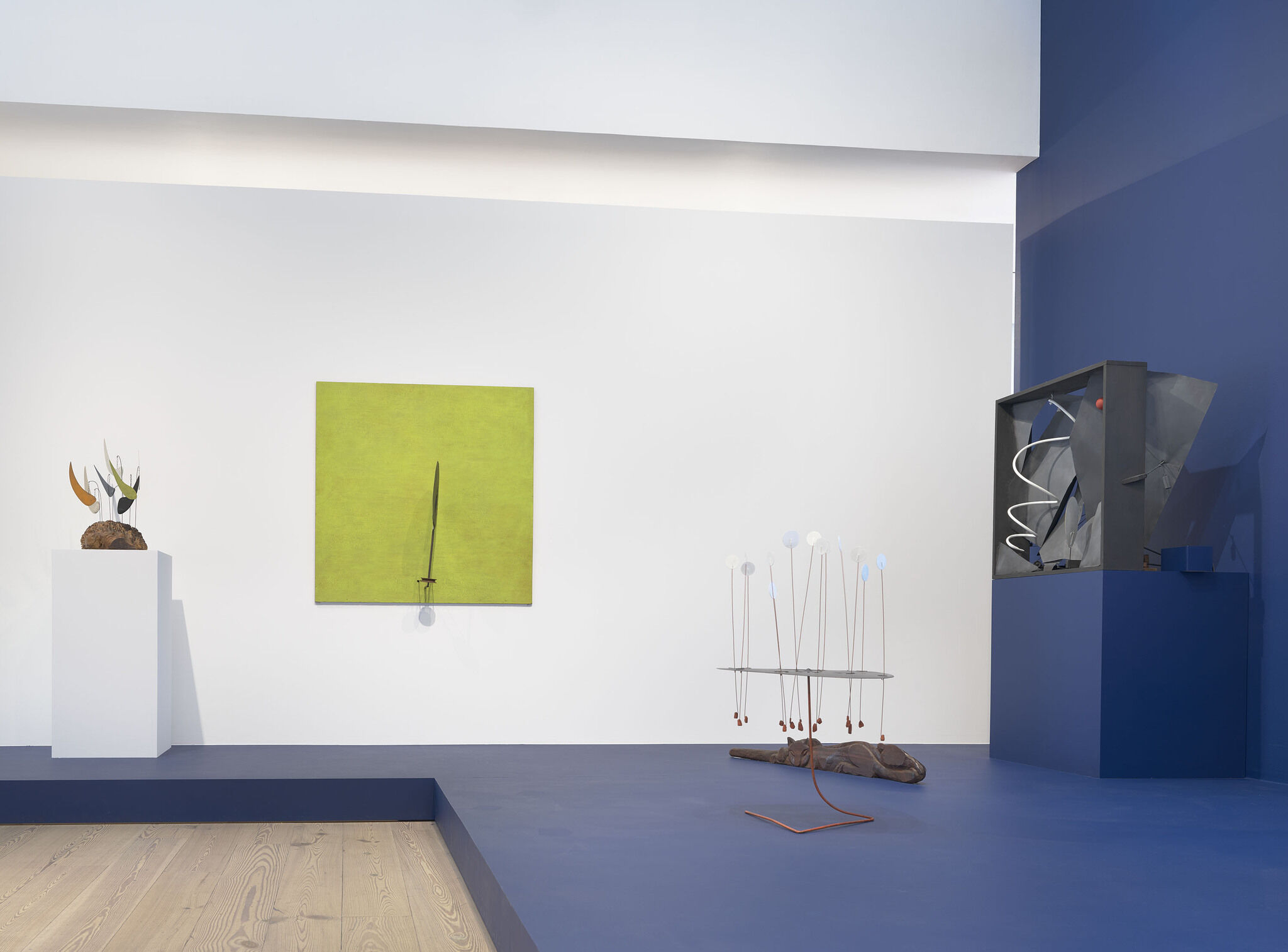

Installation view of Calder: Hypermobility (Whitney Museum of American Art, New York, June 9-October 23, 2017). From left to right, back to front: Alexander Calder, Myrtle Burl, 1941, Calder Foundation, New York, Mary Calder Rower Bequest, 2011; Alexander Calder, Square, c. 1934, Calder Foundation, New York, promised gift of Holton Rower; Alexander Calder, Double Cat, 1930, Whitney Museum of American Art, New York, purchase with funds from the Howard and Jean Lipman Foundation, Inc. 69.256; Alexander Calder, Aspen, 1948, Calder Foundation, New York; Alexander Calder, Black Frame, 1934, Calder Foundation, New York ©2017 Calder Foundation, New York/ Artists Rights Society (ARS), New York, N.Y. Photograph Ron Amstutz
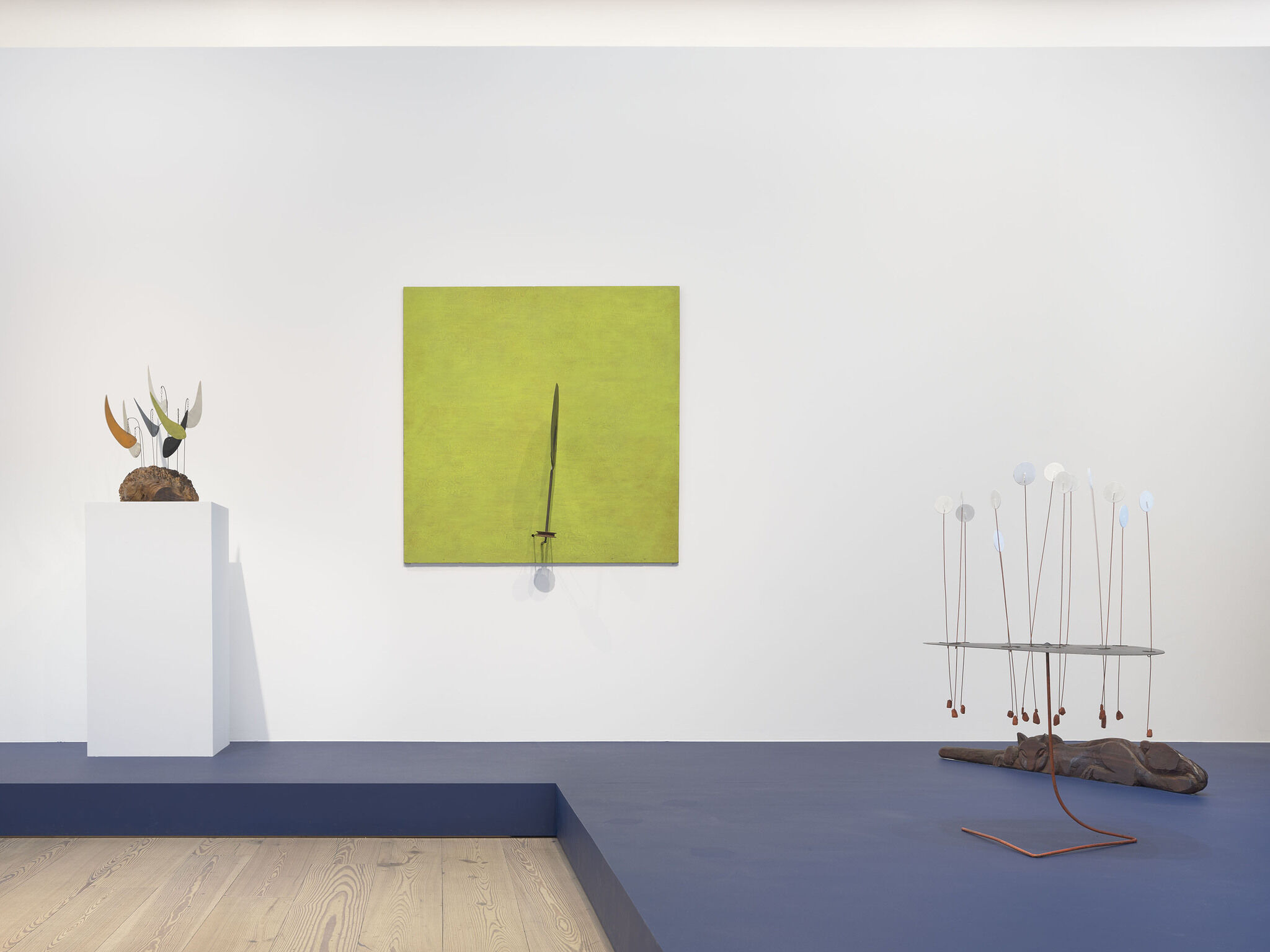

Installation view of Calder: Hypermobility (Whitney Museum of American Art, New York, June 9-October 23, 2017). From left to right, back to front: Alexander Calder, Myrtle Burl, 1941, Calder Foundation, New York, Mary Calder Rower Bequest, 2011; Alexander Calder, Square, c. 1934, Calder Foundation, New York, promised gift of Holton Rower; Alexander Calder, Double Cat, 1930, Whitney Museum of American Art, New York, purchase with funds from the Howard and Jean Lipman Foundation, Inc. 69.256; Alexander Calder, Aspen, 1948, Calder Foundation, New York ©2017 Calder Foundation, New York/ Artists Rights Society (ARS), New York, N.Y. Photograph Ron Amstutz
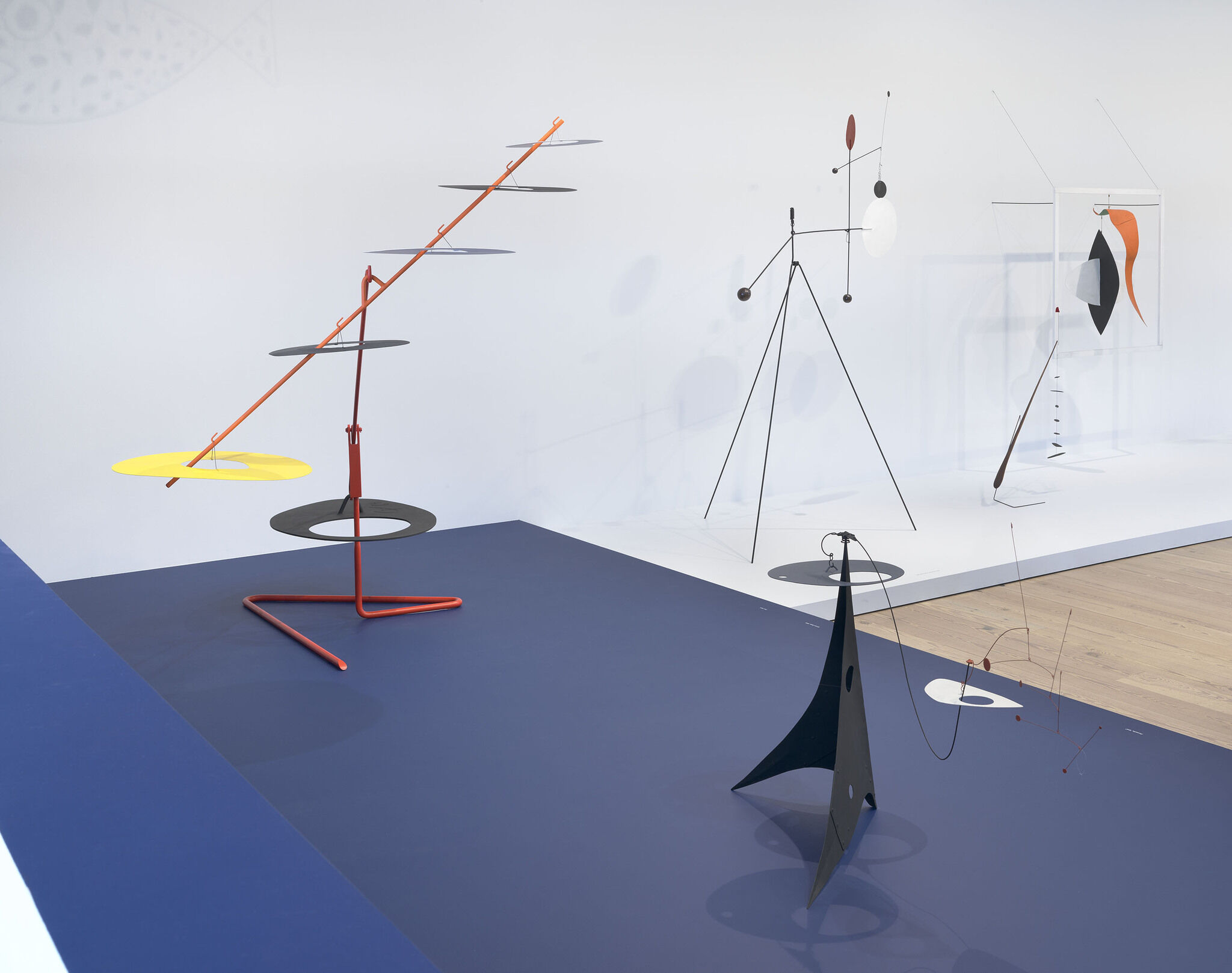

Installation view of Calder: Hypermobility (Whitney Museum of American Art, New York, June 9-October 23, 2017). Clockwise, starting in bottom right corner: Alexander Calder, Parasite, 1947, Calder Foundation, New York, promised gift of Holton Rower; Alexander Calder, Smoke Rings, 1968, Nahmad Collection; Alexander Calder, Red, White, Black and Brass, 1934, Calder Foundation, New York, promised gift of Alexander S. C. Rower; Alexander Calder, Untitled, 1942, Calder Foundation, New York; Alexander Calder, Snake and the Cross, 1936, Calder Foundation, New York ©2017 Calder Foundation, New York/ Artists Rights Society (ARS), New York, N.Y. Photograph Ron Amstutz
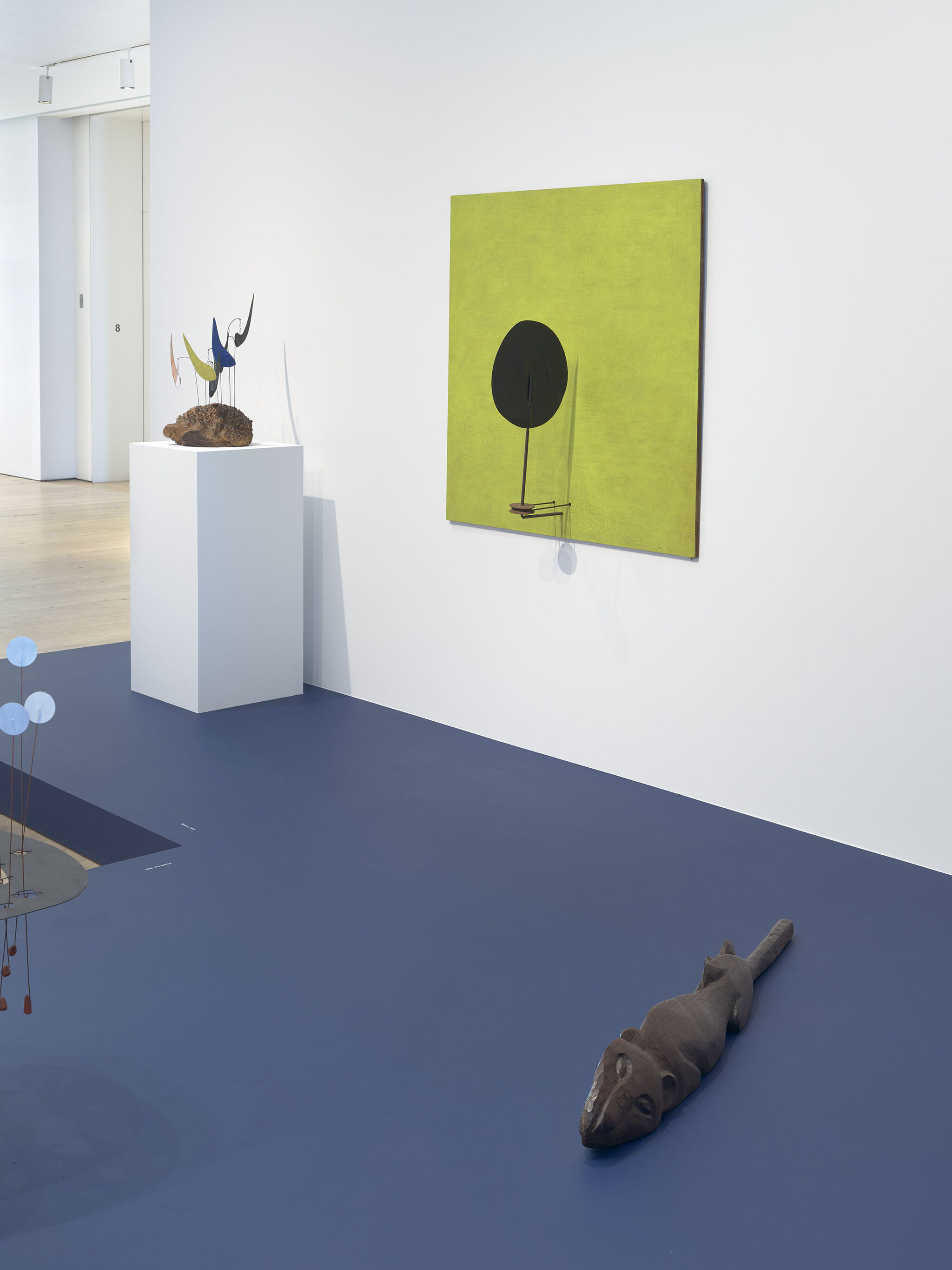

Installation view of Calder: Hypermobility (Whitney Museum of American Art, New York, June 9-October 23, 2017). Clockwise, starting in bottom right corner: Alexander Calder, Double Cat, 1930, Whitney Museum of American Art, New York, purchase with funds from the Howard and Jean Lipman Foundation, Inc. 69.256; Alexander Calder, Aspen, 1948, Calder Foundation, New York; Alexander Calder, Myrtle Burl, 1941, Calder Foundation, New York, Mary Calder Rower Bequest, 2011; Alexander Calder, Square, c. 1934, Calder Foundation, New York, promised gift of Holton Rower ©2017 Calder Foundation, New York/ Artists Rights Society (ARS), New York, N.Y. Photograph Ron Amstutz
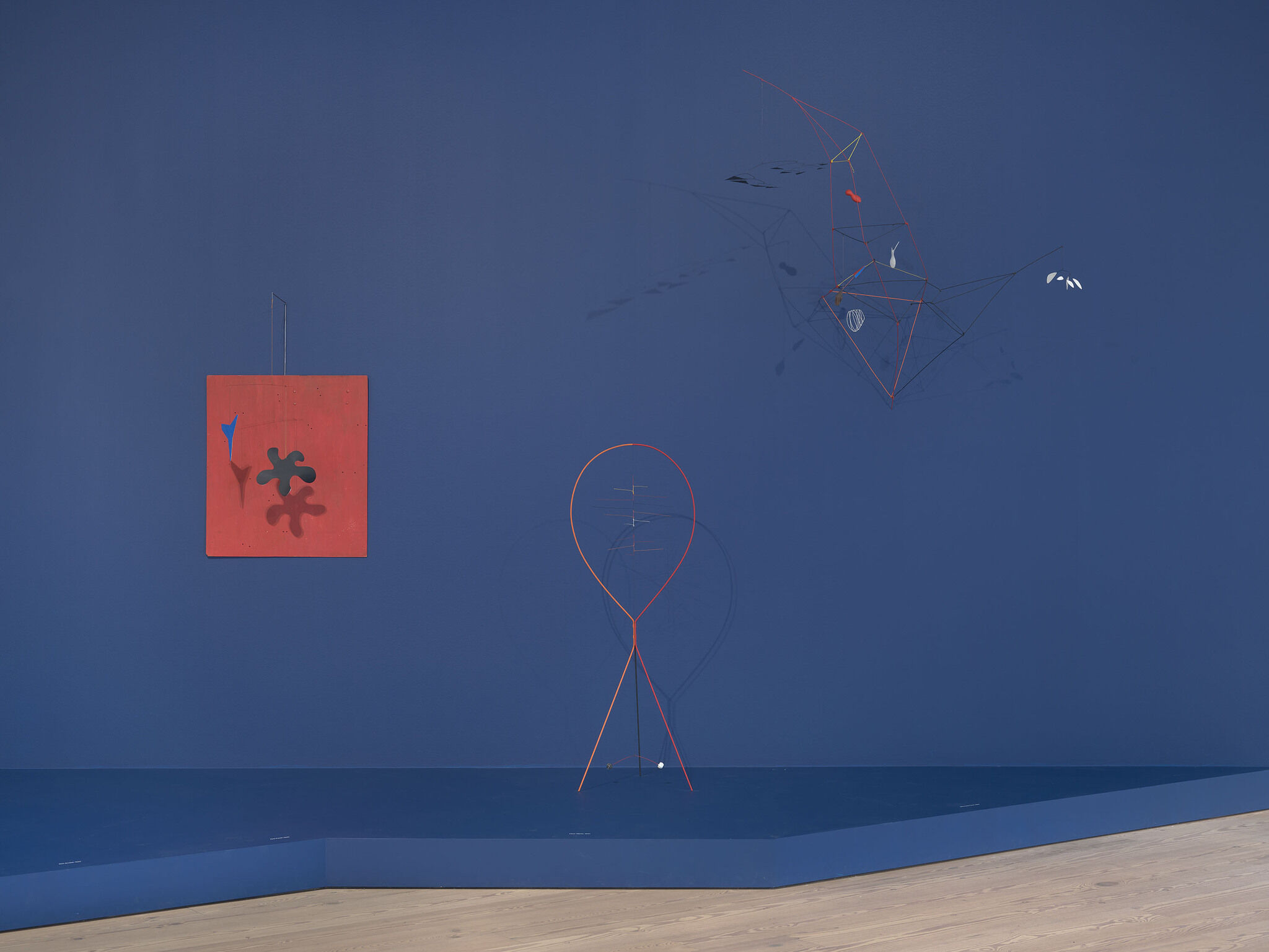

Installation view of Calder: Hypermobility (Whitney Museum of American Art, New York, June 9-October 23, 2017). From left to right: Alexander Calder, Red Panel, 1936, Calder Foundation, New York; Alexander Calder, Hourglass, 1941, The Lipman Family Foundation, long-term loan to the Whitney Museum of American art, New York; Alexander Calder, Bifurcated Tower, 1950, Whitney Museum of American Art, New York, purchased with funds from the Howard and Jean Lipman Foundation, Inc. and exchange 73.31a-f ©2017 Calder Foundation, New York/ Artists Rights Society (ARS), New York, N.Y. Photograph Ron Amstutz
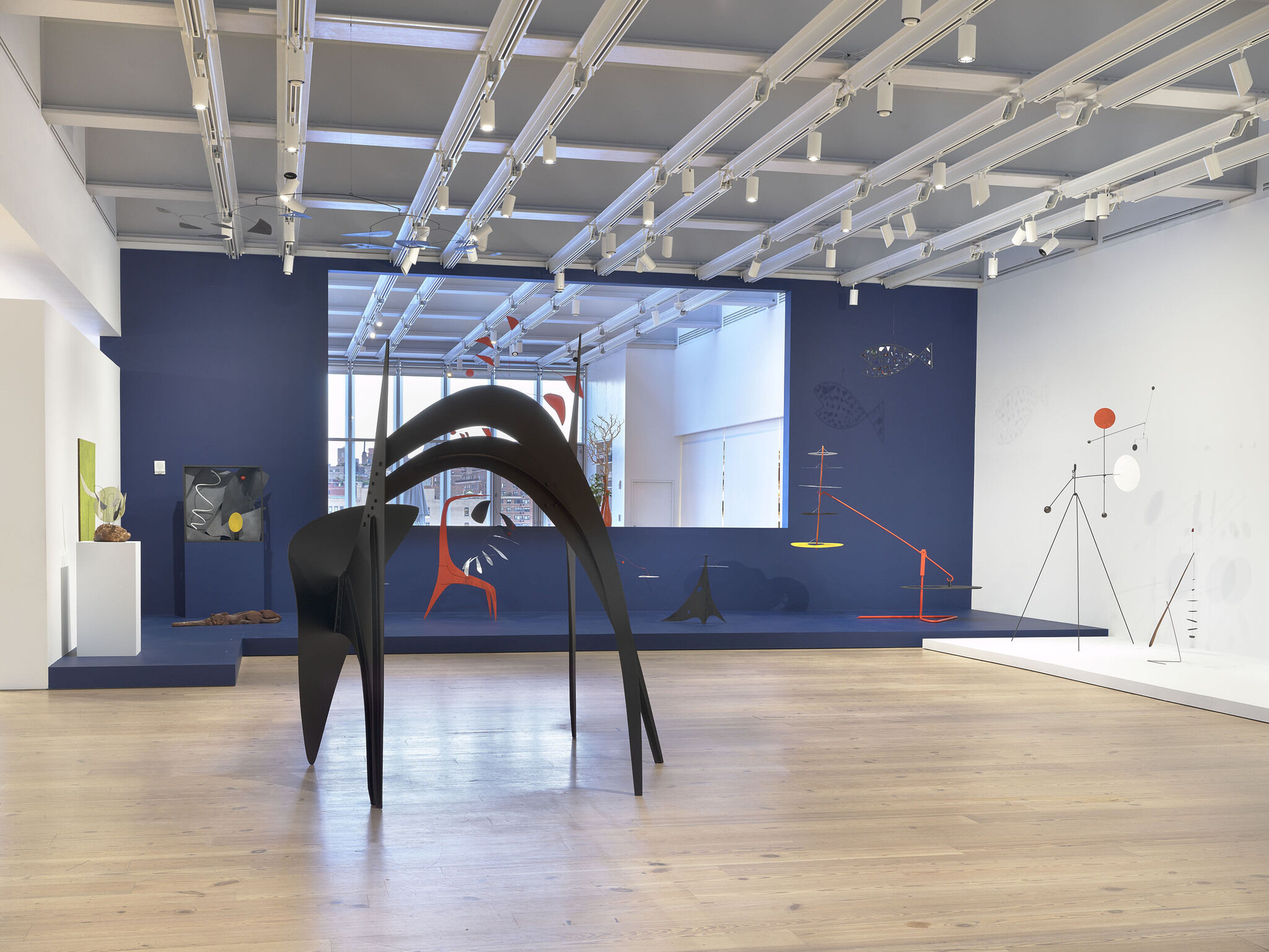

Installation view of Calder: Hypermobility (Whitney Museum of American Art, New York, June 9-October 23, 2017). Center, floor: Alexander Calder, The Arches, 1959, Whitney Museum of American art, New York, gift of Howard and Jean Lipman 82.44a-e. Center, hanging: Alexander Calder, Black Lace, c. 1947, Calder Foundation, New York. Left to right, back to front; Alexander Calder, Square, c. 1934, Calder Foundation, New York, promised gift of Holton Rower; Alexander Calder, Myrtle Burl, 1941, Calder Foundation, New York, Mary Calder Rower Bequest, 2011; Alexander Calder, Black Frame, 1934, Calder Foundation, New York; Alexander Calder, Double Cat, 1930, Whitney Museum of American Art, New York, purchase with funds from the Howard and Jean Lipman Foundation, Inc. 69.256; Alexander Calder, Aluminum Leaves, Red Post, 1941, The Lipman Family foundation, long-term loan to the Whitney Museum of American Art, New York; Alexander Calder, Big Red, 1959, Whitney Museum of American Art, New York, purchase with funds from the Friends of the Whitney Museum of American art and by exchange 61.46a-c; Alexander Calder, Parasite, 1947, Calder Foundation, New York, promised gift of Holton Rower; Alexander Calder, Smoke Rings, 1968, Nahmad Collection; Alexander Calder, Fish, 1944, Whitney Museum of American Art, New York, bequest of Richard S. Zeisler 2007.82; Alexander Calder, Red, White, Black and Brass, 1934, Calder Foundation, New York, promised gift of Alexander S. C. Rower; Alexander Calder, Untitled, 1942, Calder Foundation, New York ©2017 Calder Foundation, New York/ Artists Rights Society (ARS), New York, N.Y. Photograph Ron Amstutz
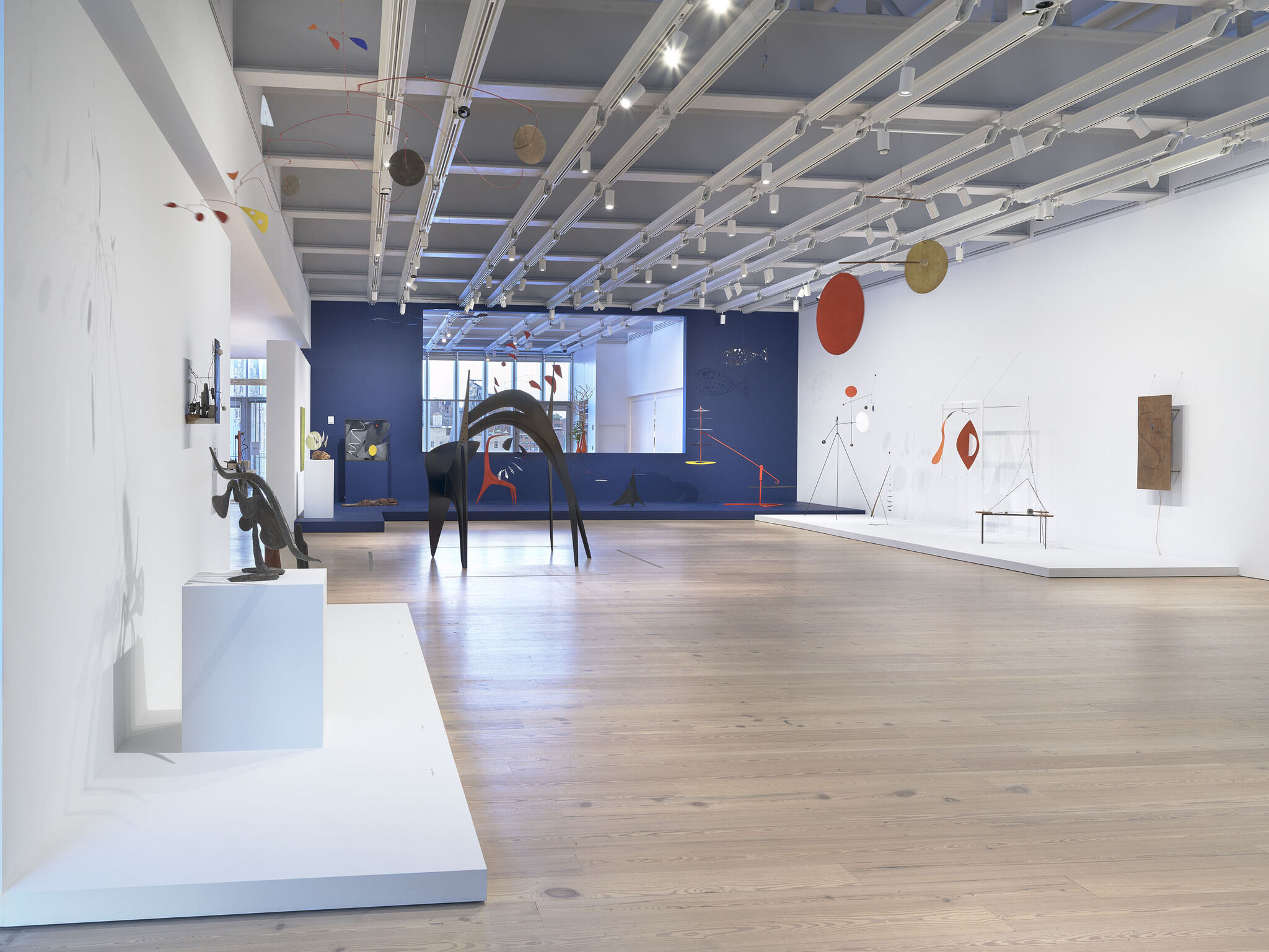

Installation view of Calder: Hypermobility (Whitney Museum of American Art, New York, June 9-October 23, 2017). Clockwise, starting in bottom left corner: Alexander Calder, Octopus, 1944, Harvard Art Museums/Fogg Museum, Cambridge, Massachusetts, gift of Lois Orswell; Alexander Calder, Two Spheres, 1931, Calder Foundation, New York, promised gift of Holton Rower; Alexander Calder, Triple Gong, c. 1948, Calder Foundation, New York, promised gift of Holton Rower; Alexander Calder, Fish, 1944, Whitney Museum of American Art, New York, bequest of Richard S. Zeisler 2007.82; Alexander Calder, Red Disc and Gong, 1940, Calder Foundation, New York, promised gift of Holton Rower; Alexander Calder, S and Star, 1941, Calder Foundation, New York; Alexander Calder, Untitled, 1938, Calder Foundation, New York, promised gift of Alexander S. C. Rower; Alexander Calder, Snake and the Cross, 1936, Calder Foundation, New York; Alexander Calder, Untitled, 1942, Calder Foundation, New York; Alexander Calder, Red, White, Black and Brass, 1934, Calder Foundation, New York, promised gift of Alexander S. C. Rower; Alexander Calder, Fish, 1944, Whitney Museum of American Art, New York, bequest of Richard S. Zeisler 2007.82; Alexander Calder, Smoke Rings, 1968, Nahmad Collection; Alexander Calder, Parasite, 1947, Calder Foundation, New York, promised gift of Holton Rower; Alexander Calder, Big Red, 1959, Whitney Museum of American Art, New York, purchase with funds from the Friends of the Whitney Museum of American art and by exchange 61.46a-c; Alexander Calder, Aluminum Leaves, Red Post, 1941, The Lipman Family Foundation, long-term loan to the Whitney Museum of American Art, New York; Alexander Calder, Black Frame, 1934, Calder Foundation, New York; Alexander Calder, Double Cat, Whitney Museum of American Art, New York, purchase with funds from the Howard and Jean Lipman Foundation, Inc. 69.256; Alexander Calder, Myrtle Burl, 1941, Calder Foundation, New York, Mary Calder Rower Bequest, 2011; Alexander Calder, Square, c. 1934, Calder Foundation, New York, promised gift of Holton Rower; Alexander Calder, Red Panel, c. 1934, Calder Foundation, New York, promised gift of Alexander S. C. Rower ©2017 Calder Foundation, New York/ Artists Rights Society (ARS), New York, N.Y. Photograph Ron Amstutz
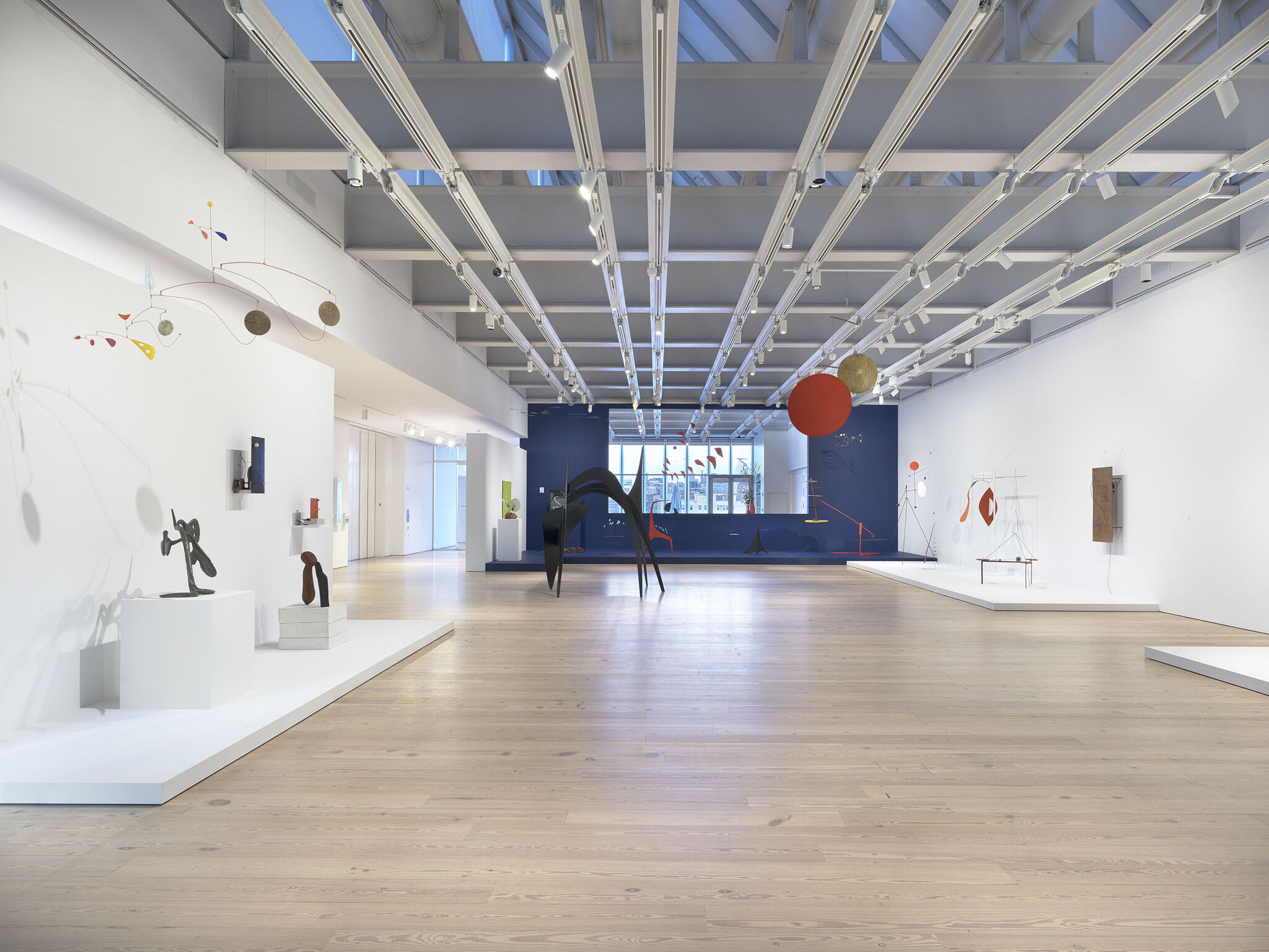

Installation view of Calder: Hypermobility (Whitney Museum of American Art, New York, June 9-October 23, 2017). Left to right, top to bottom: Alexander Calder, Triple Gong, c. 1948, Calder Foundation, New York, promised gift of Holton Rower; Alexander Calder, Octopus, 1944, Harvard Art Museums/Fogg Museum, Cambridge, Massachusetts, gift of Lois Orswell; Alexander Calder, Two Spheres, 1931, Calder Foundation, New York, promised gift of Holton Rower; Alexander Calder, Red Panel, c. 1934, Calder Foundation, New York, promised gift of Alexander S. C. Rower; Alexander Calder, Machine motorisée, 1933, Calder Foundation, New York; Alexander Calder, Black Lace, c. 1947, Calder Foundation, New York; Alexander Calder, Square, c. 1934, Calder Foundation, New York, promised gift of Holton Rower; Alexander Calder, Myrtle Burl, 1941, Calder Foundation, New York, Mary Calder Rower Bequest, 2011; Alexander Calder, The Arches, 1959, Whitney Museum of American Art, New York, gift of Howard and Jean Lipman 82.44a-e; Alexander Calder, Double Cat, 1930, Whitney Museum of American Art, New York, purchase with funds from the Howard and Jean Lipman Foundation, Inc. 69.256; Alexander Calder, Aspen, 1948, Calder Foundation, New York; Alexander Calder, Big Red, 1959, Whitney Museum of American Art, New York, purchase with funds from the Friends of the Whitney Museum of American Art and by exchange 61.46a-c; Alexander Calder, Aluminum Leaves, Red Post, 1941, The Lipman Family Foundation, long-term loan to the Whitney Museum of American art, New York; Alexander Calder, Parasite, 1947, Calder Foundation, New York, promised gift of Holton Rower; Alexander Calder, Smoke Rings, 1968, Nahmad Collection; Alexander Calder, Red Disc and Gong, 1940, Calder Foundation, New York, promised gift of Holton Rower; Alexander Calder, Fish, 1944, Whitney Museum of American Art, New York, bequest of Richard S. Zeisler 2007.82; Alexander Calder, Red, White, Black and Brass, 1934, Calder Foundation, New York, promised gift of Alexander S. C. Rower; Alexander Calder, Untitled, 1942, Calder Foundation, New York; Alexander Calder, Snake and the Cross, 1936, Calder Foundation, New York; Alexander Calder, Untitled, 1938, Calder Foundation, New York, promised gift of Alexander S. C. Rower; Alexander Calder, S and Star, 1941, Calder Foundation, New York ©2017 Calder Foundation, New York/ Artists Rights Society (ARS), New York, N.Y. Photograph Ron Amstutz
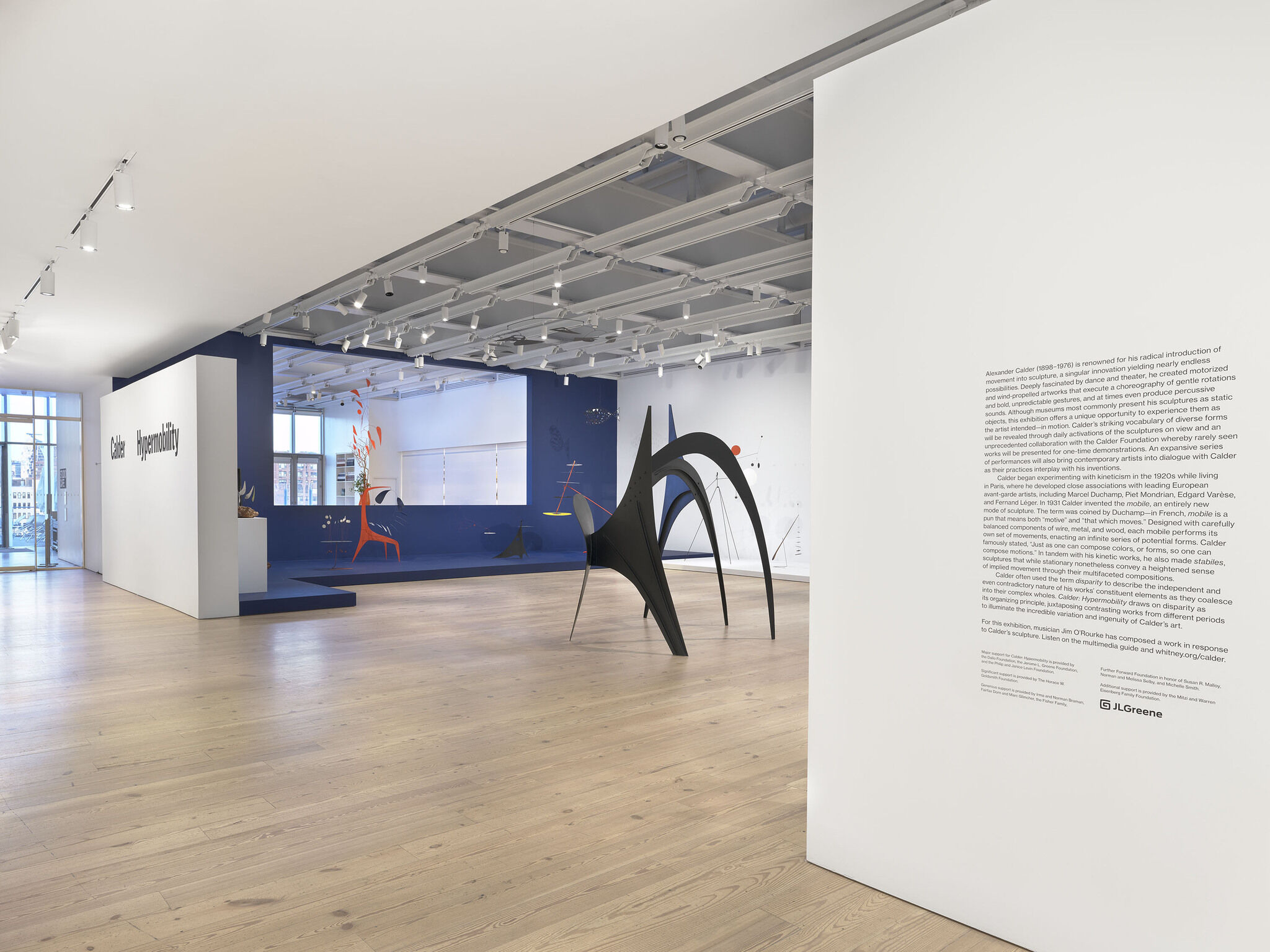

Installation view of Calder: Hypermobility (Whitney Museum of American Art, New York, June 9-October 23, 2017). From left to right, top to bottom: Alexander Calder, Myrtle Burl, 1941, Calder Foundation, New York, Mary Calder Rower Bequest, 2011; Alexander Calder, Aspen, 1948, Calder Foundation, New York; Alexander Calder, Big Red, 1959, Whitney Museum of American Art, New York, purchase with funds from the Friends of the Whitney Museum of American Art and by exchange 61.46a-c; Alexander Calder, Aluminum Leaves, Red Post, 1942, The Lipman Family Foundation, long-term loan to the Whitney Museum of American Art, New York; Alexander Calder, Black Lace, c. 1947, Calder Foundation, New York; Alexander Calder, Parasite, 1947, Calder Foundation, New York, promised gift of Holton Rower; Alexander Calder, Fish, 1944, Whitney Museum of American Art, New York, bequest of Richard S. Zeisler 2007.82; Alexander Calder, Smoke Rings, 1968, Nahmad Collection; Alexander Calder, The Arches, 1959, Whitney Museum of American Art, New York, gift of Howard and Jean Lipman 82.44a-e; Alexander Calder, Red, White, Black and Brass, 1934, Calder Foundation, New York, promised gift of Alexander S. C. Rower; Alexander Calder, Untitled, 1942, Calder Foundation, New York ©2017 Calder Foundation, New York/ Artists Rights Society (ARS), New York, N.Y. Photograph Ron Amstutz
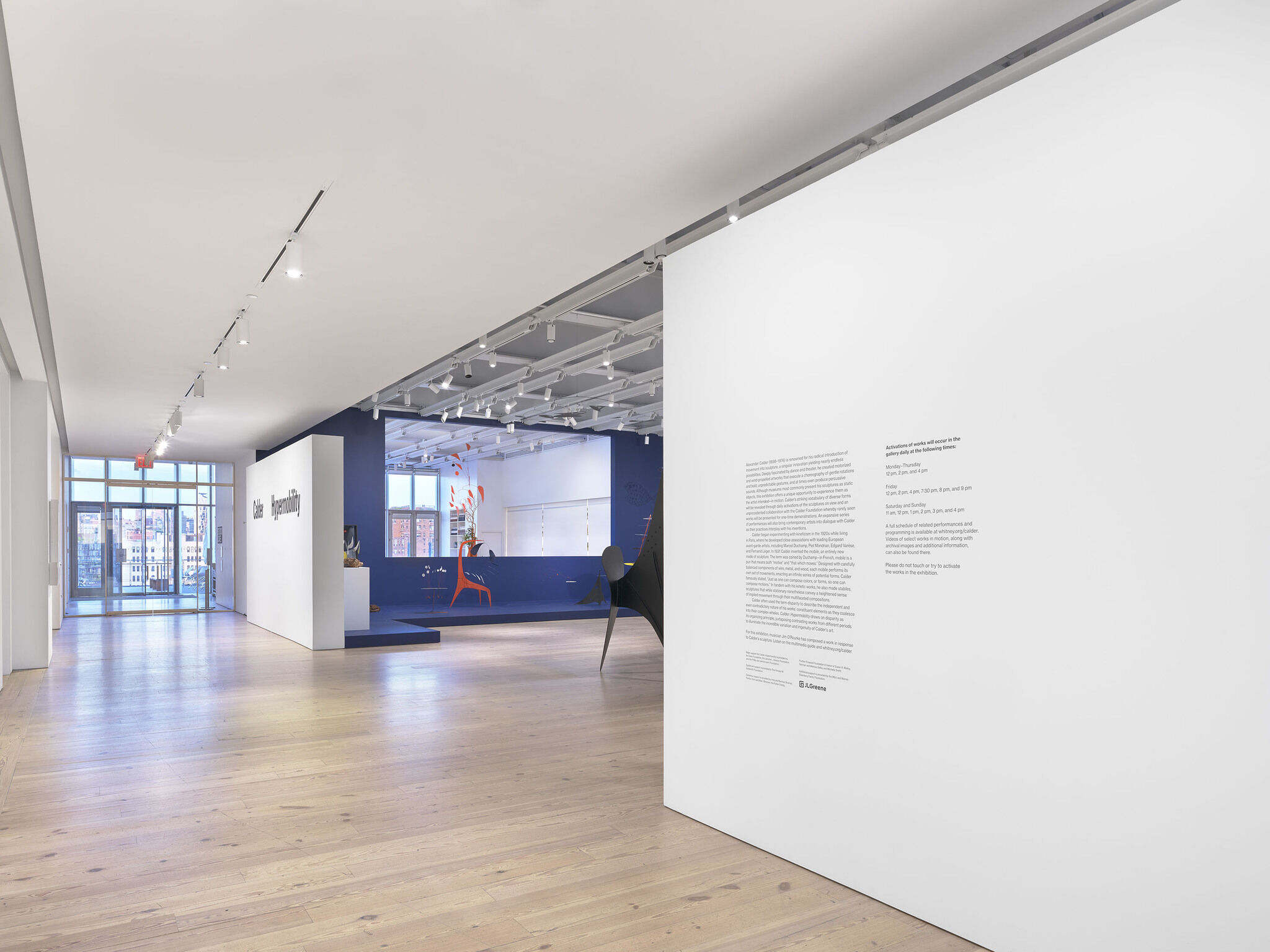

Installation view of Calder: Hypermobility (Whitney Museum of American Art, New York, June 9-October 23, 2017). From left to right, top to bottom: Alexander Calder, Myrtle Burl, 1941, Calder Foundation, New York, Mary Calder Rower Bequest, 2011; Alexander Calder, Black Frame, 1934, Calder Foundation, New York; Alexander Calder, Double Cat, 1930, Whitney Museum of American Art, New York, purchase with funds from the Howard and Jean Lipman Foundation, Inc. 69.256; Alexander Calder, Aspen, 1948, Calder Foundation, New York; Alexander Calder, Big Red, 1959, Whitney Museum of American Art, New York, purchase with funds from the Friends of the Whitney Museum of American Art and by exchange 61.46a-c; Alexander Calder, Aluminum Leaves, Red Post, 1941, The Lipman Family Foundation, long-term loan to the Whitney Museum of American Art, New York; Alexander Calder, Parasite, 1947, Calder Foundation, New York, promised gift of Holton Rower; Alexander Calder, The Arches, 1959, Whitney Museum of American Art, New York, gift of Howard and Jean Lipman 82.44a-e; Alexander Calder, Smoke Rings, 1968, Nahmad Collection ©2017 Calder Foundation, New York/ Artists Rights Society (ARS), New York, N.Y. Photograph Ron Amstutz
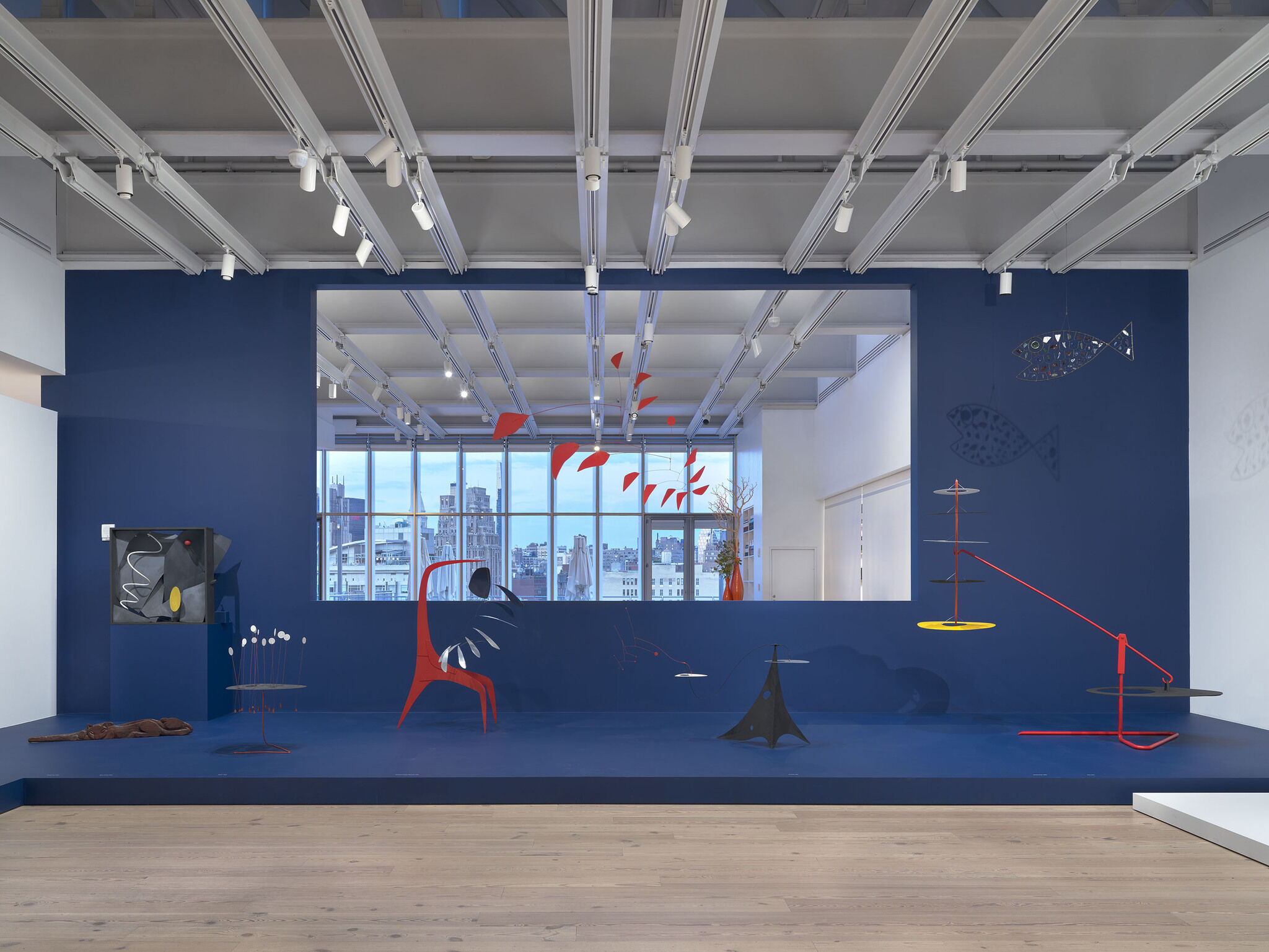

Installation view of Calder: Hypermobility (Whitney Museum of American Art, New York, June 9-October 23, 2017). From left to right, top to bottom: Alexander Calder, Double Cat, 1930, Whitney Museum of American Art, New York, purchase with funds from the Howard and Jean Lipman Foundation, Inc. 69.256; Alexander Calder, Black Frame, 1934, Calder Foundation, New York; Alexander Calder, Aspen, 1948, Calder Foundation, New York; Alexander Calder, Aluminum Leaves, Red Post, 1941, The Lipman Family Foundation, long-term loan to the Whitney Museum of American Art, New York; Alexander Calder, Big Red, 1959, Whitney Museum of American Art, New York, purchase with funds from the Friends of the Whitney Museum of American Art and by exchange 61.46a-c; Alexander Calder, Parasite, 1947, Calder Foundation, New York, promised gift of Holton Rower; Alexander Calder, Smoke Rings, 1968, Nahamd Collection; Alexander Calder, Fish, Whitney Museum of American Art, New York, bequest of Richard S. Zeisler 2007.82 ©2017 Calder Foundation, New York/ Artists Rights Society (ARS), New York, N.Y. Photograph Ron Amstutz
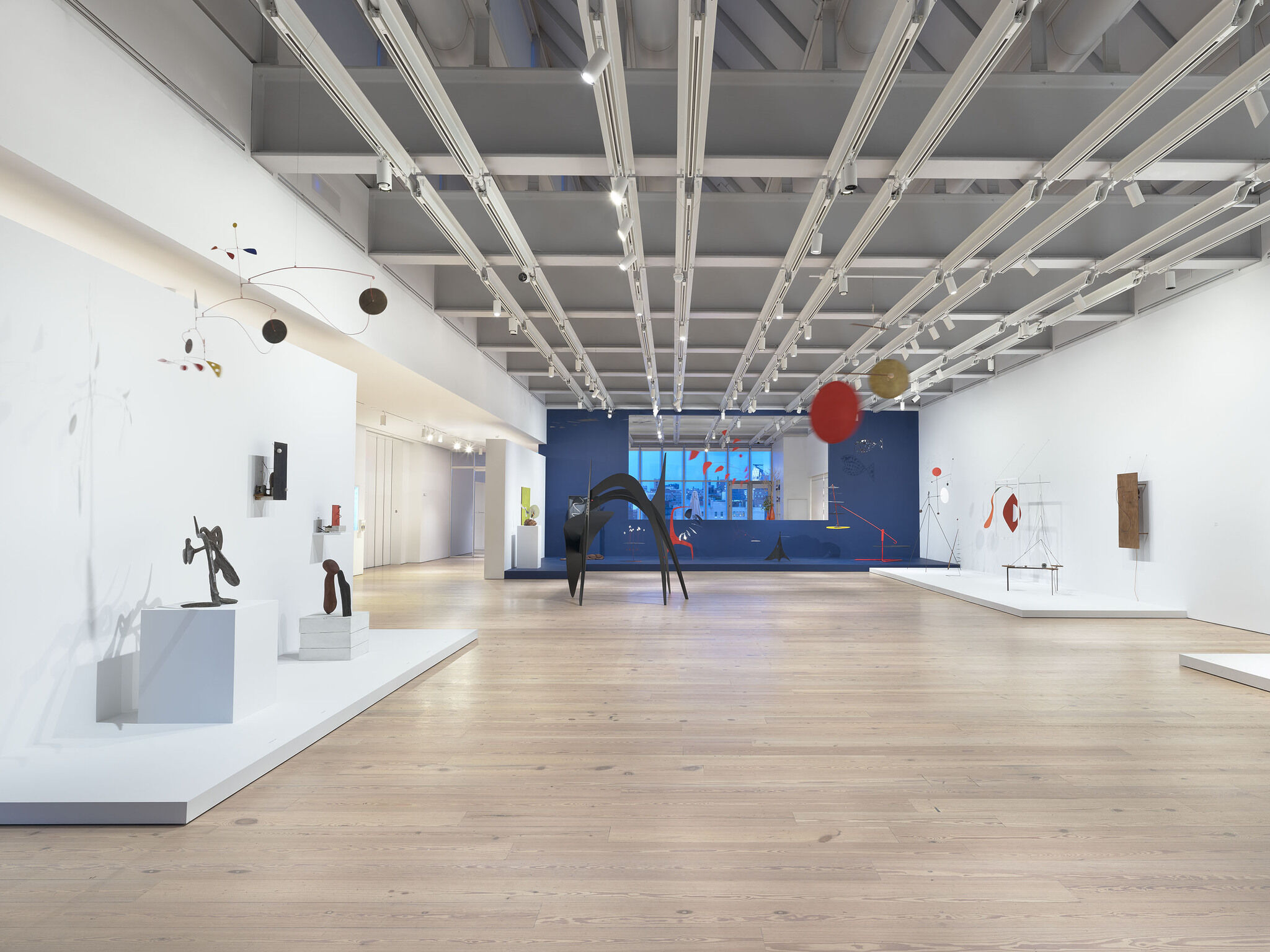

Installation view of Calder: Hypermobility (Whitney Museum of American Art, New York, June 9-October 23, 2017). Clockwise, beginning in bottom left corner: Alexander Calder, Octopus, 1944, Harvard Art Museums/Fogg Museum, Cambridge, Massachusetts, gift of Lois Orswell; Alexander Calder, Triple Gong, c. 1948, Calder Foundation, New York, promised gift of Holton Rower; Alexander Calder, Two Spheres, 1931, Calder Foundation, promised gift of Holton Rower; Alexander Calder, Red Panel, c. 1934, Calder Foundation, New York, promised gift of Alexander S. C. Rower; Alexander Calder, Myrtle Burl, 1941, Calder Foundation, New York, Mary Calder Rower Bequest, 2011; Alexander Calder, Square, c. 1934, Calder Foundation, New York, promised gift of Holton Rower; Alexander Calder, Black Lace, c. 1947, Calder Foundation, New York; Alexander Calder, Double Cat, 1930, Whitney Museum of American Art, New York, purchase with funds from the Howard and Jean Lipman Foundation, Inc. 69.256; Alexander Calder, Aspen, 1948, Calder Foundation, New York; Alexander Calder, Aluminum Leaves, Red Post, 1941, The Lipman Family Foundation, long-term loan to the Whitney Museum of American Art, New York; Alexander Calder, Big Red, 1959, Whitney Museum of American Art, New York, purchase with funds from the Friends of the Whitney Museum of American Art and by exchange 61.46a-c; Alexander Calder, Parasite, 1947, Calder Foundation, New York, promised gift of Holton Rower; Alexander Calder, Smoke Rings, 1968, Nahmad Collection; Alexander Calder, Fish, 1944, Whitney Museum of American Art, New York, bequest of Richard S. Zeisler; Alexander Calder, Red Disc and Gong, 1940, Calder Foundation, New York, promised gift of Holton Rower; Alexander Calder, Red, White, Black and Brass, 1934, Calder Foundation, New York, promised gift of Alexander S. C. Rower; Alexander Calder; Alexander Calder, Untitled, 1942, Calder Foundation, New York; Snake and the Cross, 1936, Calder Foundation, New York; Alexander Calder, Untitled, 1938, Calder Foundation, New York, promised gift of Alexander S.C. Rower ©2017 Calder Foundation, New York/ Artists Rights Society (ARS), New York, N.Y. Photograph Ron Amstutz
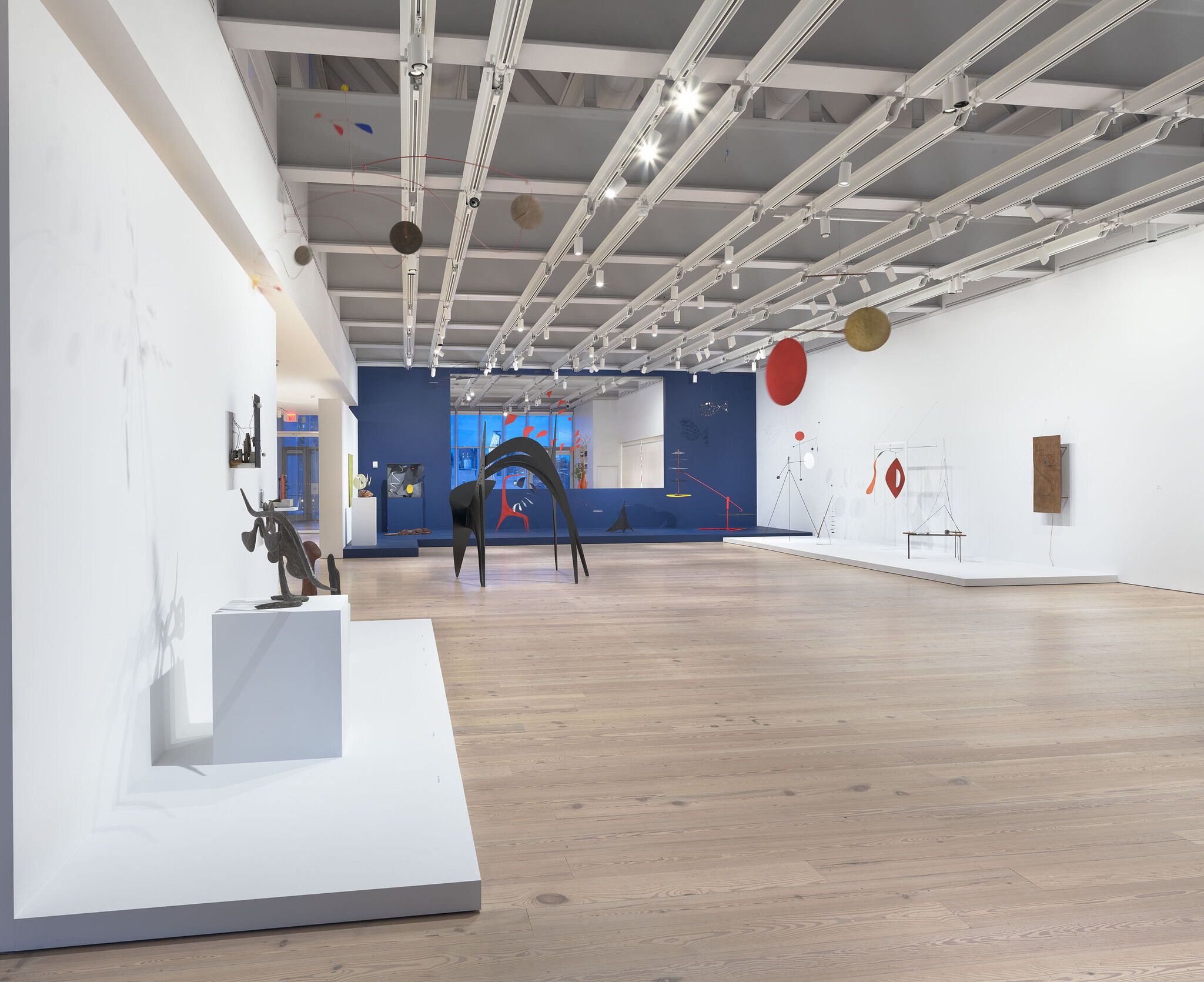

Installation view of Calder: Hypermobility (Whitney Museum of American Art, New York, June 9-October 23, 2017). Counter clockwise beginning in top left: Alexander Calder, Triple Gong, c. 1948, Calder Foundation, New York, promised gift of Holton Rower; Alexander Calder, Red Disc and Gong, 1940, Calder Foundation, New York, promised gift of Holton Rower; Alexander Calder, S and Star, 1941, Calder Foundation, New York; Alexander Calder, Untitled, 1938, Calder Foundation, New York, promised gift of Alexander S. C. Rower; Alexander Calder, Snake and the Cross, 1936, Calder Foundation, New York; Alexander Calder, Untitled, 1942, Calder Foundation, New York; Alexander Calder, Red, White, Black and Brass, 1934, Calder Foundation, New York, promised gift of Alexander S. C. Rower; Alexander Calder, Fish, 1944, Whitney Museum of American Art, New York, bequest of Richard S. Zeisler 2007.82; Alexander Calder, Smoke Rings, 1968, Nahmad Collection; Alexander Calder, Parasite, 1947, Calder Foundation, New York, promised gift of Holton Rower; Alexander Calder, Big Red, 1959, Whitney Museum of American Art, New York, purchase with funds from the Friends of the Whitney Museum of American Art and by exchange 61.46a-c; Alexander Calder, Aluminum Leaves, Red Post, 1941, The Lipman Family Foundation, long-term loan to the Whitney Museum of American Art, New York; Alexander Calder, Black Frame, 1934, Calder Foundation, New York; Alexander Calder, Double Cat, Whitney Museum of American Art, New York, purchase with funds from the Howard and Jean Lipman Foundation, Inc. 69.256; Alexander Calder, Myrtle Burl, 1941, Calder Foundation, New York, Mary Calder Rower Bequest, 2011; Alexander Calder, Square, c. 1934, Calder Foundation, New York, promised gift of Holton Rower; Alexander Calder, Red Panel, c. 1934, Calder Foundation, New York, promised gift of Alexander S. C. Rower; Alexander Calder, Machine motorisée, 1933, Calder Foundation, New York; Alexander Calder, Octopus, 1944, Harvard Art Museums/Fogg Museum, Cambridge, Massachusetts, gift of Lois Orswell; Alexander Calder, Two Spheres, 1931, Calder Foundation, New York, promised gift of Holton Rower; ©2017 Calder Foundation, New York/ Artists Rights Society (ARS), New York, N.Y. Photograph Ron Amstutz
Explore works from this exhibition
in the Whitney's collection
View 10 works
In the News
“One-time displays of rarely seen works, led by the foundation, as well as motorized sculptures that haven’t been seen in motion for decades”
—The New York Times
“The Whitney allows visitors to see the works as Calder intended—in motion.”
—New Yorker
“A one-of-a-kind sound performance”
—The Wall Street Journal
“It is a show about motion that stops you in your tracks.”
—WNYC
“A high-spirited showcase on the top floor of the Whitney Museum of American Art, goes a long way to recapturing the guile and peculiarity of his spinning wires and discs”
—NY Art Beat
“Calder: Hypermobility will be a popular show, if not for the sheer imagination on view”
—Observer
“'I always knew that Calder was not an entertainer, but you really see here that he is not trying to entertain you,' Rower says. 'And if it’s not entertaining, then what is it? It’s not a sculpture, it’s not a picture—it’s an experience.'”
—artnet


